Scottish Shelf Model. Part 4: East Coast of Lewis and Harris Sub-Domain
Part 4 of the hydrodynamic model developed for Scottish waters.
3 Hydrodynamic Model Development
3.1 Introduction
This section of the report describes the setting up of the ECLH model mesh, bathymetry, boundary conditions and the calibration of the flow model. Model documentation and lessons learnt during this process have been captured in Volume 2 of this report.
3.2 ECLH flow model setup
3.2.1 Model mesh
The model mesh developed for the ECLH model has been created using the SMS mesh generator. The horizontal coordinate system used has been latitude and longitude with a vertical datum of mean sea level ( MSL). Ten vertical layers have been employed within the model simulations.
The SMS Mesh generator requires coastline and boundary data to define the extent of the active and inactive mesh. Additional information is provided regarding the resolution required in user-specified domains. The resolution is based upon modelling experience, bathymetry gradient/resolution, geographical features and requirements for the study. Although the mesh generator is able to create meshes with triangular or quadrilateral elements, FVCOM requires only triangular elements.
Mesh generation can be an iterative process in order to get a mesh that varies smoothly, with triangles that do not have angles that are too acute and resolution that does not require an overly small model timestep. SMS has a number of features to allow for a smooth resolution change throughout the model domain so that adjacent element volumes do not differ by more than a factor of 0.5. Additionally the Minimum interior angle was set as 30 degrees, maximum interior angle set as 130 degrees and the maximum number of connecting elements was set as 8. These values were obtained from the FVCOM manual (Chen et al., 2013).
It had been found previously that the volume factor and the number of connecting nodes did affect the model stability.
Figure 3-1 shows the mesh at different zoom levels. Resolution in the areas close to the offshore boundary of the model is in the order of 2000m, within the central part of the model it is approximately 500m, with most of the rest of the area close to shore on the east coast of Lewis and Harris having a resolution in the order of 150m.
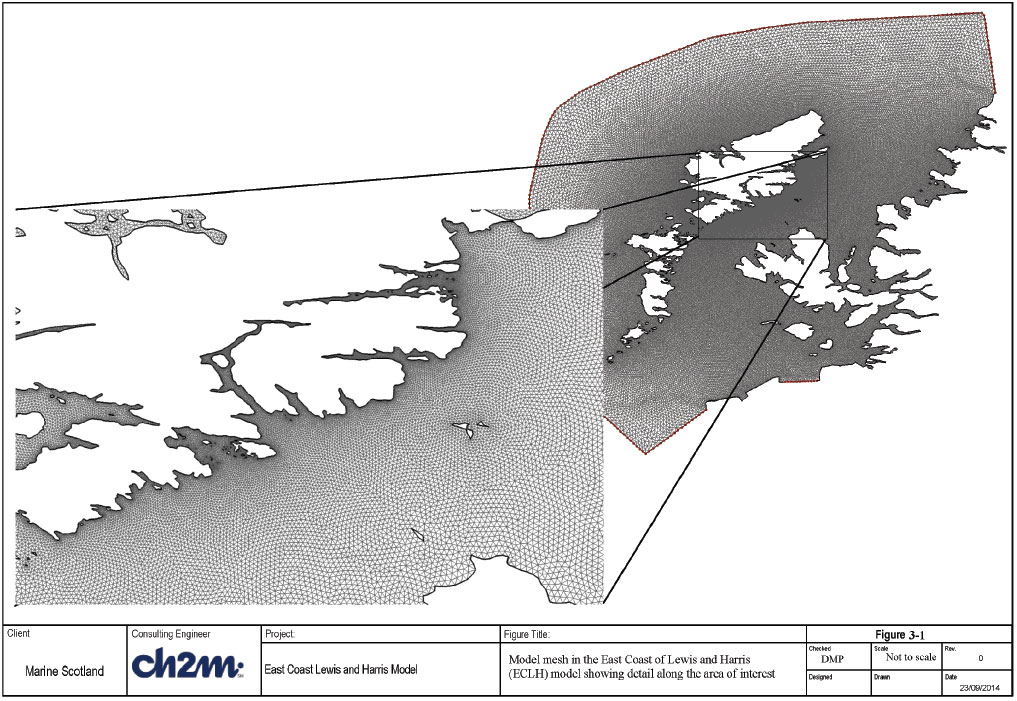
3.2.2 Model bathymetry
The ECLH model mesh was created using the SMS mesh generator. The bathymetry used for the ECLH model was derived from the same sources as the other case study models, namely:
- EMODNET (coarser and generally offshore),
- higher resolution survey bathymetry (data and other higher resolution datasets from ICES and Marine Scotland) and
- digitised Admiralty Chart data where no other data was available.
The coastline was derived from Ordnance survey coastline data.
These bathymetry datasets were combined to a common datum of MSL and interpolated onto the model mesh within the SMS mesh generator.
Figure 3-2 shows the extent of the model domain along with a zoomed in view showing detail along the east coast of Lewis and Harris which is the focus of this study. The open boundary is highlighted in red; note that there is a break in the boundary at the southern part of the model where it straddles a number of islands (Tiree and Coll). The contour levels on this and subsequent images of the model bathymetry is relative to MSL.
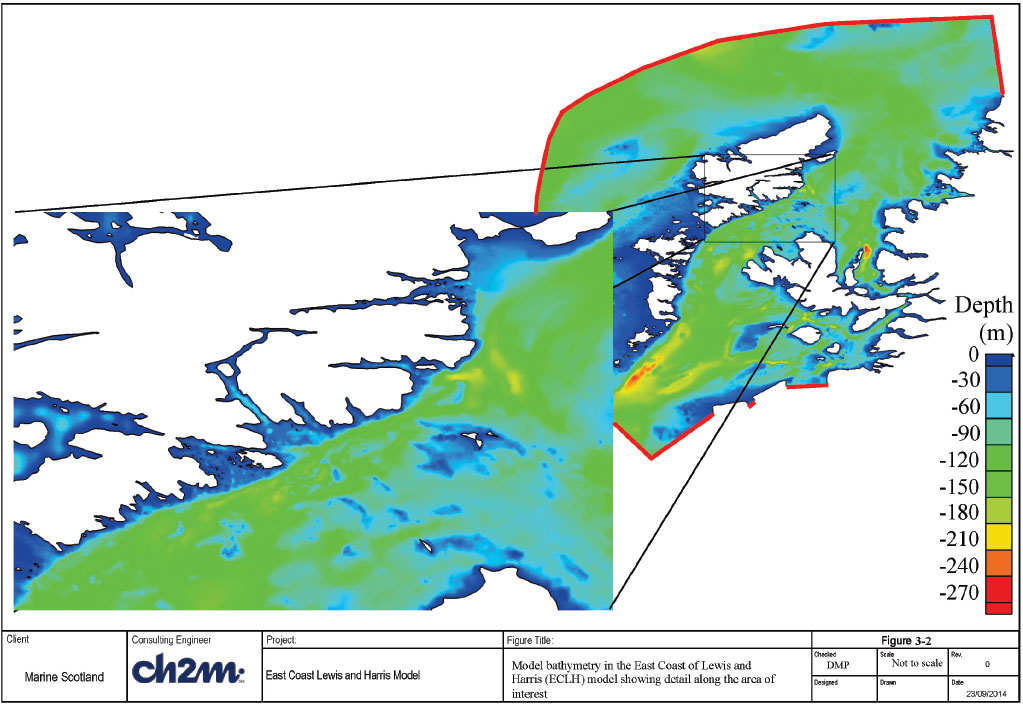
3.2.3 Boundary data
The hydrodynamic boundary data applied to the ECLH model are water levels relative to MSL, depth-averaged velocities, temperature and salinity. These were obtained from the AMM model. Initial runs to drive the hydrodynamic model made use of only a water level boundary, however it proved difficult to get the model to be stable. Therefore a nesting boundary approach has been used.
The nesting boundary consists of all of the elements on the open boundary as well as all of the attached nodes. All nodes attached to the elements on the open boundary are hereafter called "nesting nodes". Scripts have been created to automatically determine the element numbers and nesting node numbers along the open boundary. These element and node numbers are then used by another script to read in the results from the AMM model and create a netcdf nesting boundary file. For the climatological simulations described in Section 3.4, the code was amended to read in FVCOM shelf model results for the same purpose.
The data we had from the AMM model consisted of hourly water level and depth-averaged currents. As the ECLH model had 10 vertical layers, the depth-averaged velocity was applied equally at each layer, thus letting the model adjust the depth variation. The temperature and salinity were supplied as daily values for each of the AMM's 40 layers and incorporated into the nesting boundary with a time interval of 10 minutes, the same time frame as the water level and current speeds had been interpolated to. The temperature and salinity were interpolated onto the model boundary nodes for each of the models layers.
The ECLH model is run initially with constant temperature and salinity for a short warm-up period, this outputs a hotstart file which contains information about water levels, current speed and temperature/salinity. To reduce the warm-up period for the temperature and salinity, a Matlab script has been used which writes AMM temperature and salinity results to the hotstart file (over-writing the constant values in the hotstart file). This allows the follow-on ECLH model hot start conditions to match those applied at the boundary and to have suitable temperature/salinity within the model domain. The external timestep used in the simulations was 3 seconds, with Isplit set as a factor of 3 (ratio of internal to external timestep).
3.2.4 Meteorological forcing data
There are two options when including heat input into the FVCOM model; either the net heat flux inputs are provided by way of netcdf files, or FVCOM calculates it internally. NOC-L found that the shelf model was heating up too much with the former approach over a 4-month simulation. Furthermore, they found that this overheating problem was solved by allowing FVCOM to calculate the heat inputs internally. The reason for the overheating problem is due to the difference in sea surface temperature used in the Met Office model and the AMM model used for deriving initial conditions.
It is therefore advantageous to follow the NOC-L approach and have the heating calculated within the model so this is the method employed for this case study.
The meteorological forcing data was retrieved by NOC-L for 2009. This was processed and a Matlab tool produced which provided the necessary meteorological file for FVCOM. A more detailed description of the Meteorological forcing used in both the Shelf Model and the case study models can be found in Halcrow (2012), Section 3.2.5.
There were some issues with the meteorological forcing data with rain falling on dry elements, some negative evaporation (and precipitation) as well as cooling of elements that were disconnected from the main water body (at a few places along the coastline). Additionally the Met data grid did not always overlap fully the ECLH model. In order to remove issues associated with these problems, the met data was post processed to make the values zero at these locations. It was felt that this would not have a significant impact upon the overall model results.
3.2.5 River input
River discharge data was obtained from CEH (received June 2013) and encompassed all of 2009 at 15 minute intervals (Shetland had daily average data). This data was processed using a MATLAB tool which determined which mesh node to apply the river flow to. It also moved the location of a river node to the nearest land node if it was connected to two other land nodes in the same element (if connected in this way, then the river flow cannot escape the element and water levels build up artificially too high).
A river namelist file was produced along with a netcdf file for each of the rivers named in it. On further application of the Shelf model it was found that reading in over 500 river files impacted upon model performance (input/output overhead). The ECLH model was also exhibiting performance issues and therefore all of the rivers were combined into one netcdf file. This, in conjunction with using the latest version 3.1.6 of FVCOM, helped to stabilise runtimes.
The salinity in the river flow was set to 0 psu, and the temperature set to 7 degrees Celsius as this was appropriate for the nearshore temperatures from the AMM model. The river flow is distributed equally amongst all of the vertical layers.
3.3 Flow model calibration
3.3.1 Introduction
A range of datasets were available with which to calibrate the ECLH hydrodynamic model. Water level data were available for long periods at Ullapool, Kinlochbervie and Stornaway (on Lewis). Current measurements were available at a number of locations from the British Oceanographic Data Centre ( BODC) at the northern end of the model domain in the Minch as well as towards the southern end of the model and to the south of Harris. Additionally SEPA provided fish farm current data at a number of locations within our model area along the east coast of Lewis and Harris, these were all recorded at different times for a minimum of 15 days. Additionally Marine Scotland deployed two ADCP instruments along the study area (Loch Seaforth entrance and offshore in the Little Minch) for a three tide period.
The different timeframes at which the various current measurements were available, combined with the periods when we had suitable boundary and meteorological forcing data meant that it was difficult to run the model with all of the met forcing and coincident boundary conditions to the available data.
Boundary conditions were available for 2009, as was the met data. However there was only one data set (from a fish farm measurement) when current data was coincident with the met and boundary data, a direct comparison between the baroclinic model and this data is presented in section 3.3.4.
Initially, the model was run for the month of May 2009, with river input and full met forcing. The results of this simulation were compared with measured water levels at Ullapool, Kinlochbervie and Stornaway. No current data was available for direct comparison with the May 2009 run, comparisons against the current data were made by undertaking a harmonic analysis of both the model speed components as well as the observed speed components and reconstructing both the model and observed speeds. This approach removes the meteorological forcing from the data and allows the reconstruction of the two sets of speeds to a common time-frame.
3.3.2 Guidance used for model calibration
The guidance that we have used to assess the level of calibration for calibration of water levels and currents speeds is provided in Bartlett (1998) and reproduced below:-
- Water levels to within +/- 0.1m
- Speeds to within +/- 0.1m/s
- Direction to within +/- 10 degrees
- Timing of high water to within +/- 15 minutes
Alternatively some of these could be expressed in percentage terms:-
- Speeds to within +/-10-20% of observed speed
- Levels to within 10% of Spring tidal range or 15% of Neap tidal range
It is accepted that these criteria might be too testing for all regions of the modelled area. A less stringent expectation might thus be that these conditions should be satisfied for 90% of the position/time combinations evaluated.
The results from the model were gauged against this criteria.
3.3.3 Sensitivity to bed roughness
One of the main parameters that affects current speeds within a hydrodynamic model is bed roughness; this section describes the results of this sensitivity analysis.
3.3.3.1 Water level comparisons
The ECLH model had initially been run using water level boundaries only, this lead to some instability issues. Therefore a nesting boundary approach was undertaken using type 2 nesting. This meant that a file for water levels was applied along with a nesting file that contained velocities, temperature and salinity. This approach made the model much more stable.
Three simulations were undertaken for the month of May 2009 with a range of roughness lengths; 0.01, 0.04 and 0.1m to test the sensitivity of the model to this parameter.
Figures 3-3a-c show comparisons between the water levels predicted by the model for the roughness of 0.1m compared with the tide gauge measurements. The differences between the three model simulations for water levels is very small and not easily visible and therefore has not been plotted. The main effect from the changes to roughness is to the current speeds presented later.
The locations of Kinlochbervie and Ullapool are on the northwest coast of Scotland located within lochs. Unfortunately the model does not resolve these locations as well as would have been liked, although for good reason to keep the overall number of elements down (these locations are far away from the area of interest). Stornaway however is located on Lewis provides a comparison closer to the area of interest.
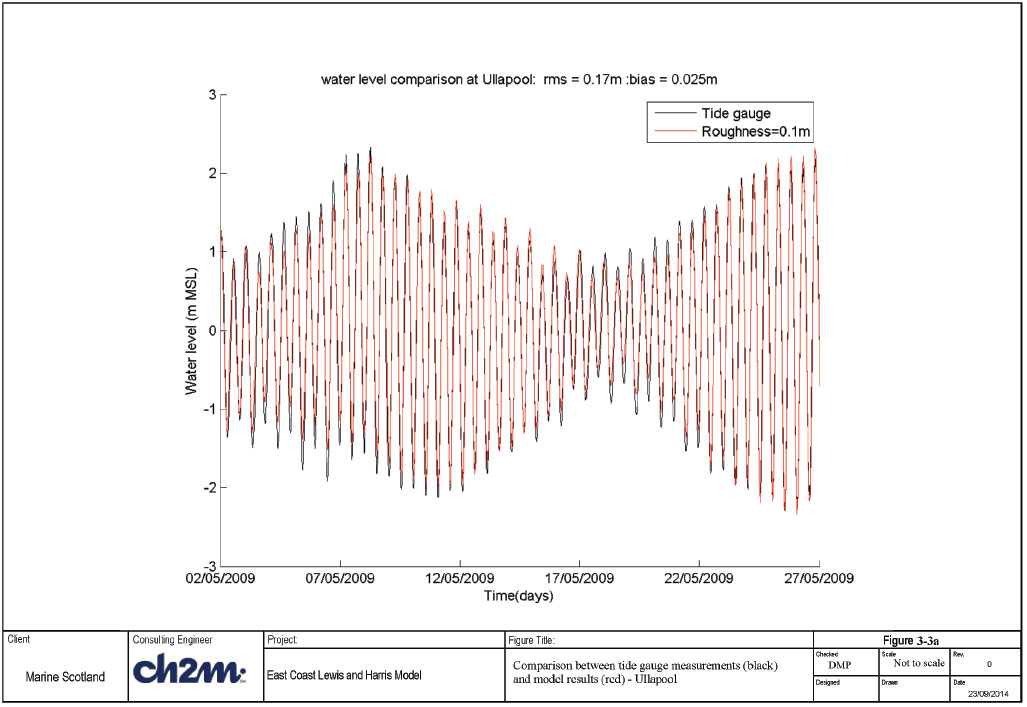
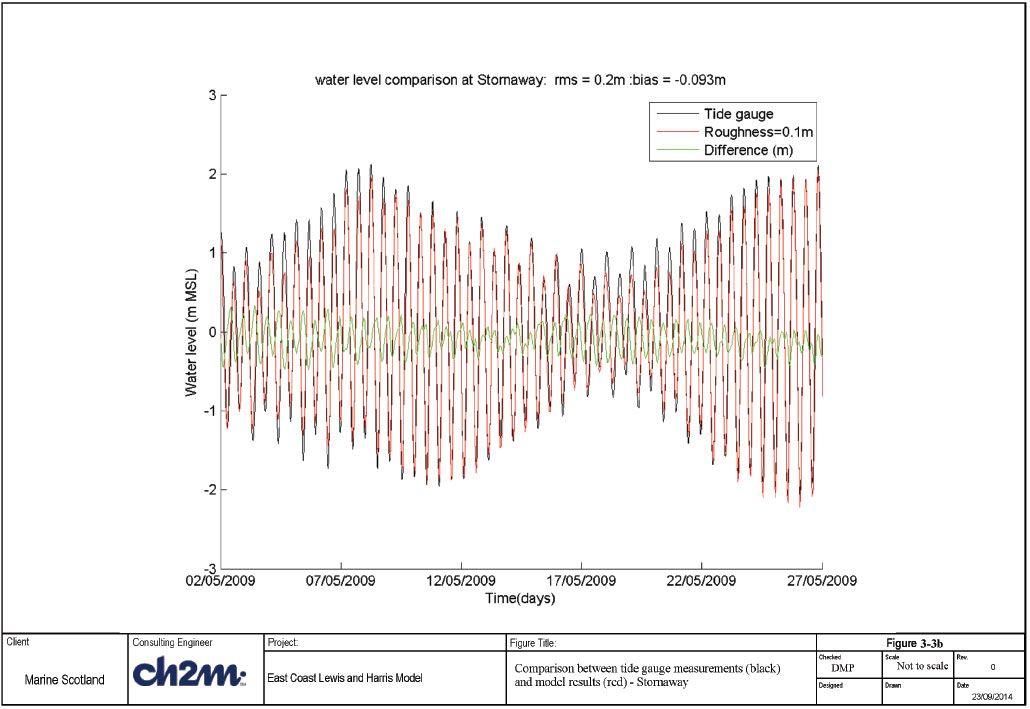
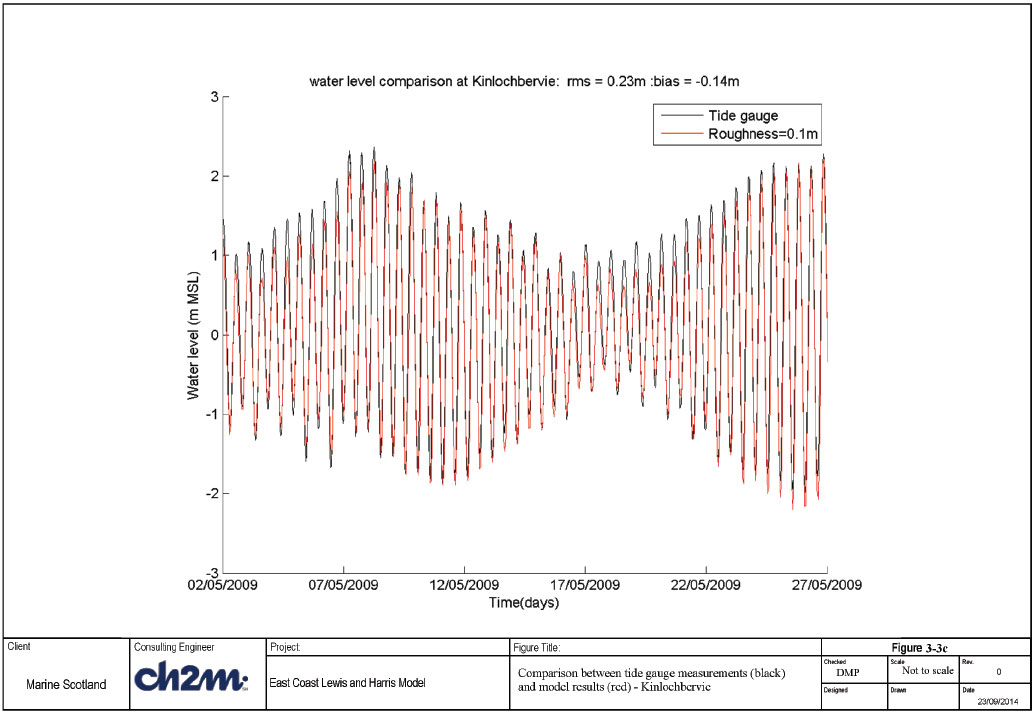
What can be seen in these plots is that the model is able to reproduce the change in the tidal signature over a spring-neap cycle reasonably well. There appears to be a small under-prediction of the tidal range during the phase where neap tidal ranges are increasing to intermediate tides but a good reproduction is made during springs. The drop from intermediate tides to neaps is reproduced well. This feature is evident at all the locations. For the Stornaway plot the difference between the model and the data is plotted in green. A tidal signature can be seen which may suggest that some constituents are not included in the model boundary conditions.
The Root Mean Square error ( RMS) and bias (mean of the difference between model and data) are also included in the title of these three figures and summarised below in Table 3.1
Table 3‑1 error statistics for comparisons of the model against measured water level data
| Ullapool | Stornaway | Kinlochbervie | |
|---|---|---|---|
| RMS error | 0.17m | 0.2m | 0.23m |
| Bias error | 0.025m | -0.093m | -0.14m |
| RMS error % (compared with neap tidal range) | 11% | 15% | 17% |
| RMS error % (compared with spring tidal range) | 4% | 5% | 5% |
It can be seen in the Figures 3-3a-c and in Table 3‑1 that the percentage errors for the spring tide are within the 10% criteria, whereas for the neap tides they are all higher up to and including 15% for Ullapool and Stornaway, but slightly higher for Kinlochbervie. Therefore in general the model meets the criteria for percentage error for most of the time and locations with the exception of neap tides at Kinlochbervie. Although the 15% is exceeded at Kinlochbervie, it is only just over, far from the area of interest and not resolved fully in the model mesh. Therefore given that the differences occur for only part of the time during a subset of tides, it is recommended that the calibration for water level be accepted. Sensitivity to bed roughness did not have a significant effect on the water levels.
3.3.4 Current speed calibration
3.3.4.1 Sensitivity test to bed roughness
The sensitivity to bed roughness was undertaken to assess how this impacted both water levels and current speeds. The water levels were not very sensitive to this parameter, however differences were observed for the current speeds in the model.
In order to assess the sensitivity, comparisons between the three model simulations with roughness lengths of 0.01, 0.04 and 0.1m and observed current meter data have been made. The data was obtained from the BODC archive at locations shown on the following Figures.
On each of the Figures 3-4a-d, current speeds from the three sensitivity simulations are shown. The remaining comparisons are displayed in Appendix A. However because the model was run for different periods than the data, harmonic analysis and then reconstruction of both the model results and the data for the time frame of the model simulation was undertaken. This had the advantage of then allowing comparison of the two sets of data (just using astronomical components) although differences in the period analysed could introduce differences.
On each of these Figures the RMS value for current speed and direction are included. All of the current speed comparisons have an RMS error of less than 0.1m/s which is within the guidance we are using. Using percentages it is more difficult to achieve the guidance range for speeds of 10-20% as the speeds are generally low.
Based upon the Figures it was decided from the statistics and visual comparison that a bed roughness of 0.1m gave marginally better results. Figures 3-5a-i show the comparisons with only the results from this simulation compared against the data.
Table 3‑2 presents the RMS errors between the model and observed data (both have been reconstructed to give astronomical currents only). Subsequent simulations therefore have a bed roughness of 0.1m.
Table 3‑2 RMS errors for current speed comparisons ( BODC data)
| Location | Current speed RMS error (m/s) |
|---|---|
| B0507784 | 0.05 |
| B0507772 | 0.07 |
| B0507760 | 0.05 |
| B0507759 | 0.06 |
| B0507747 | 0.07 |
| B0507723 | 0.08 |
| B0507711 | 0.07 |
| B0507692 | 0.07 |
| B0507680 | 0.06 |
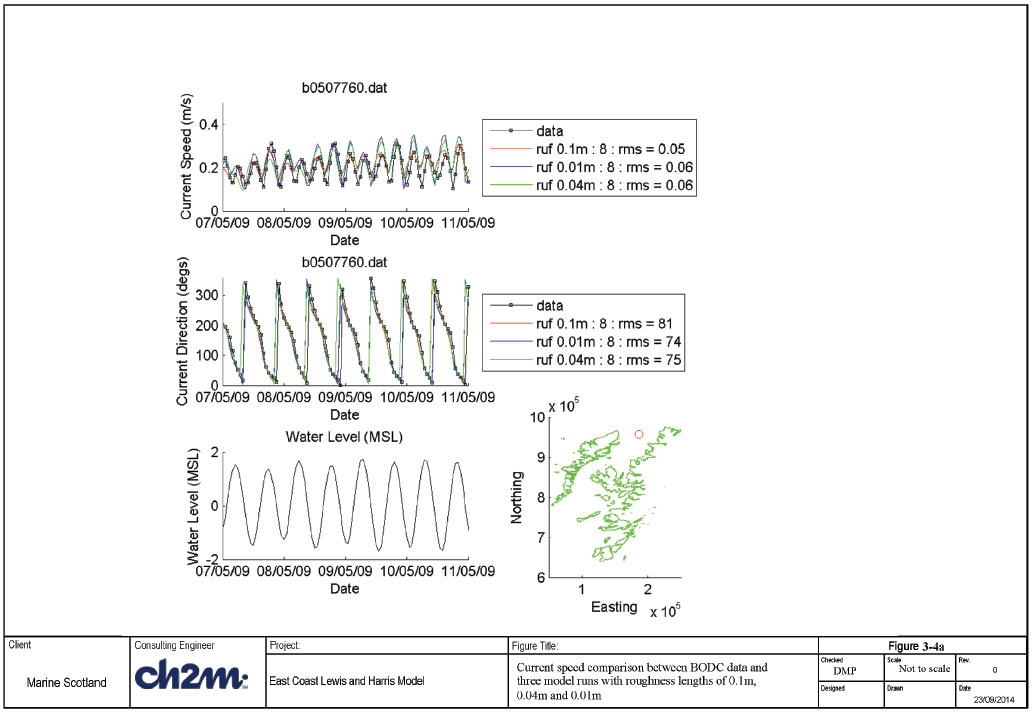
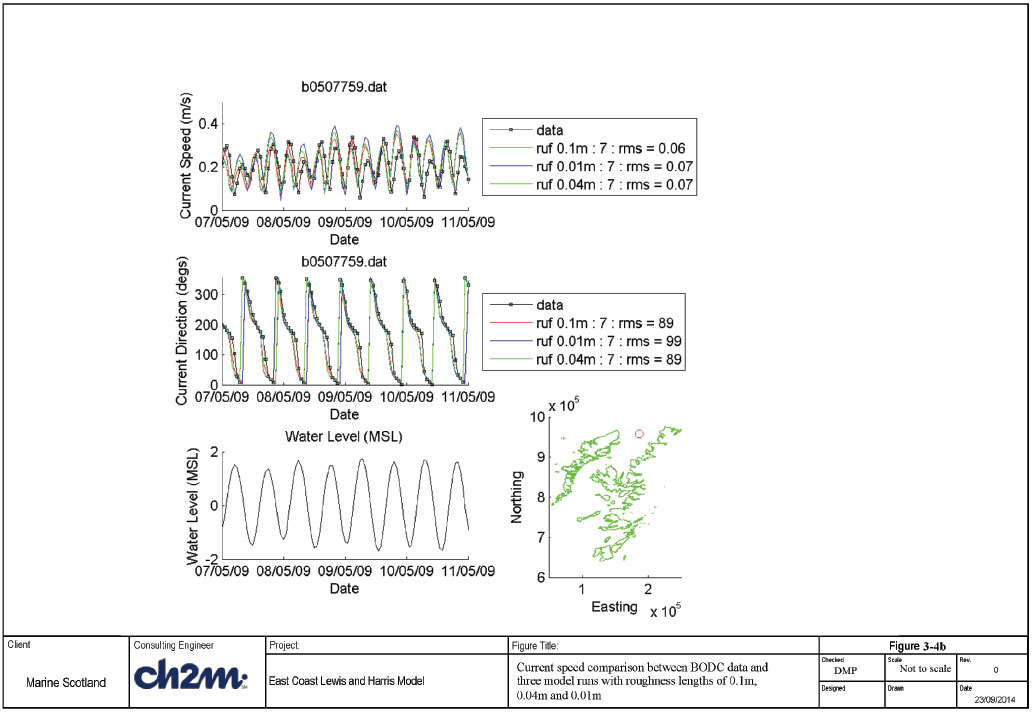
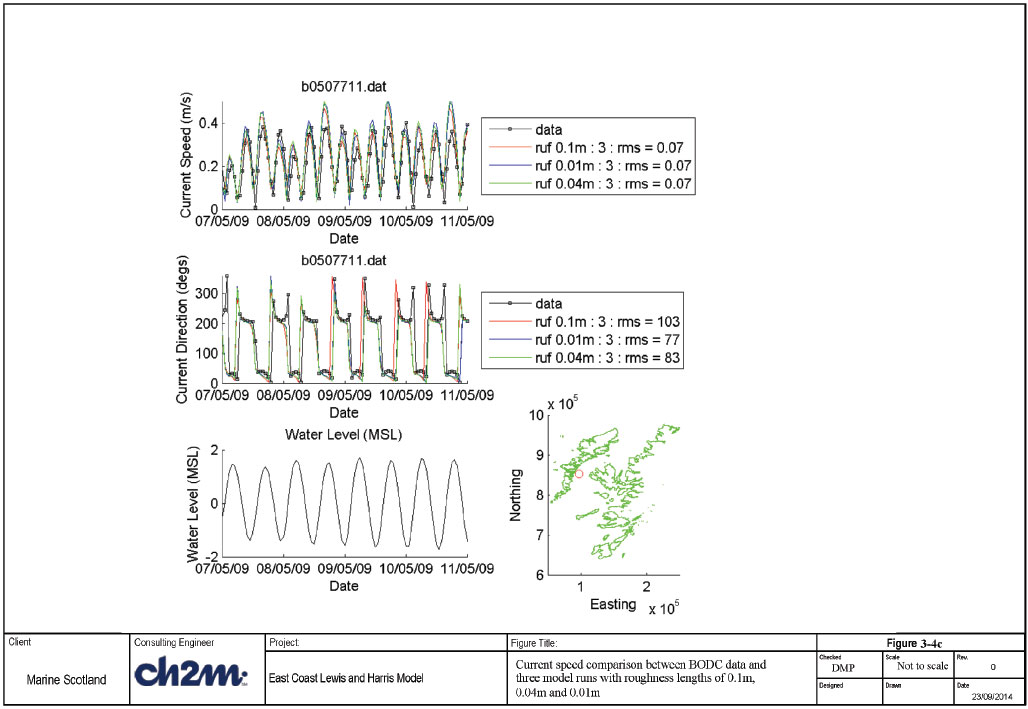
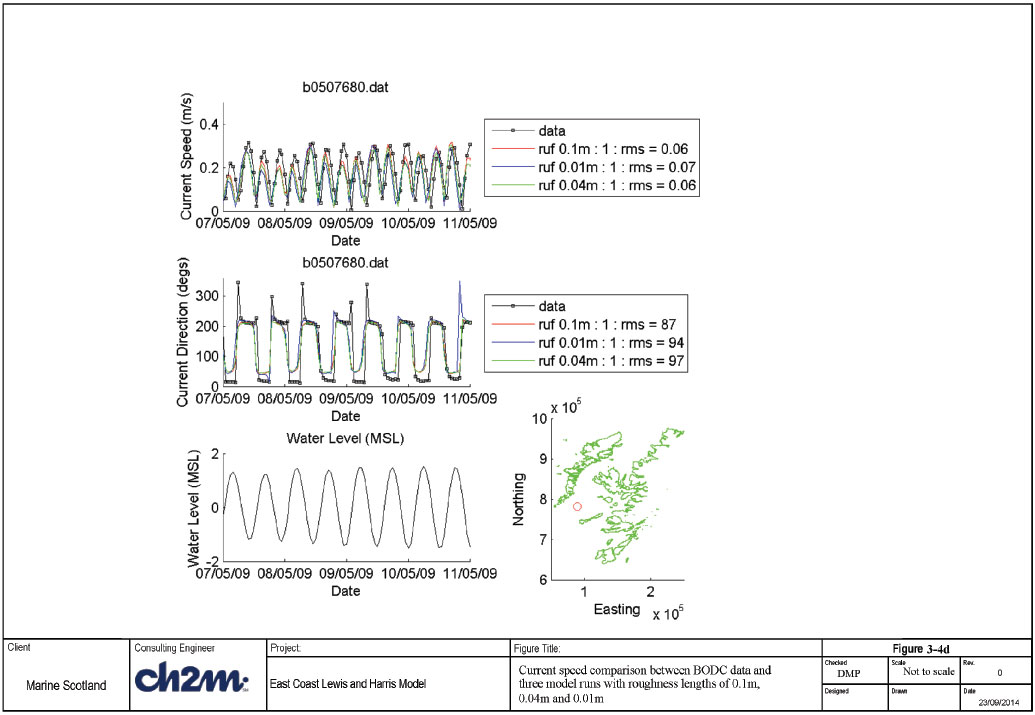
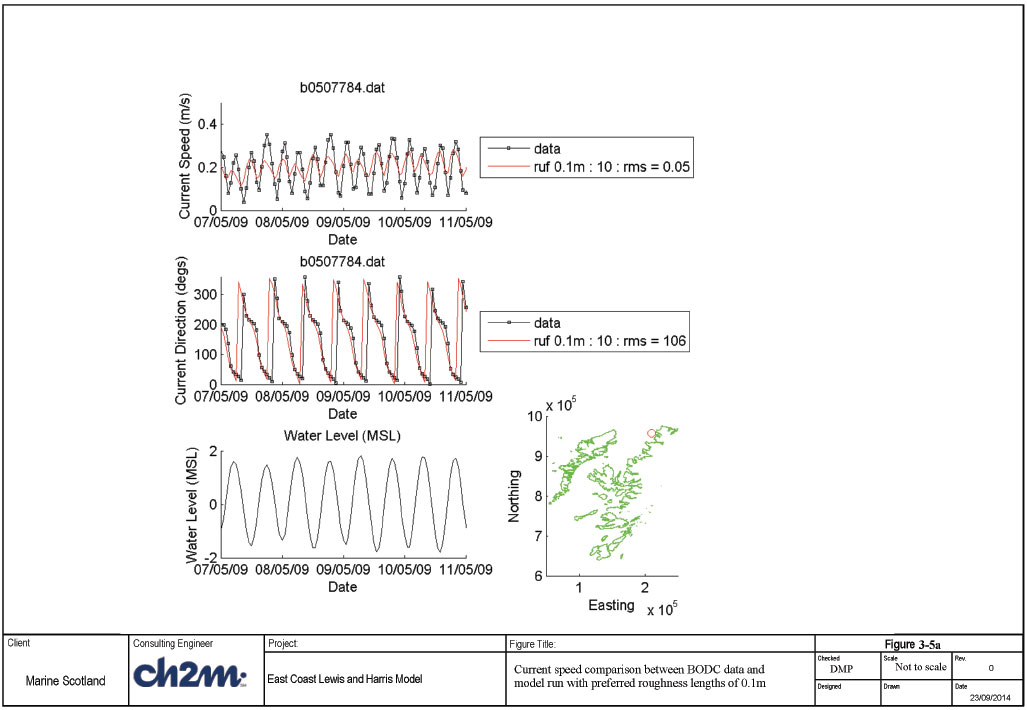
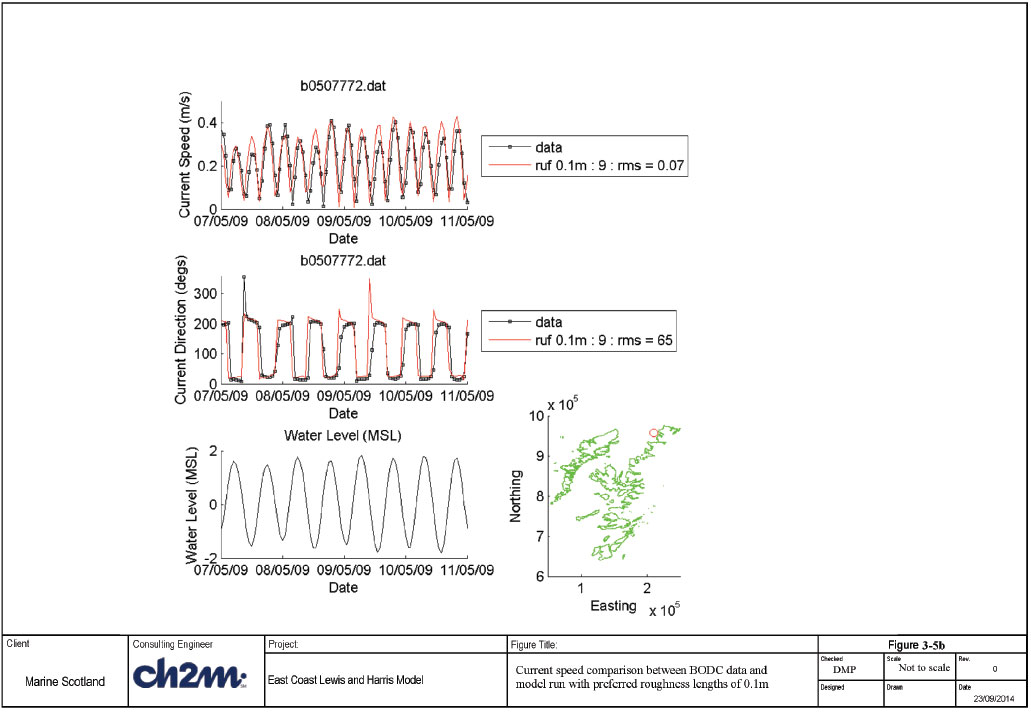
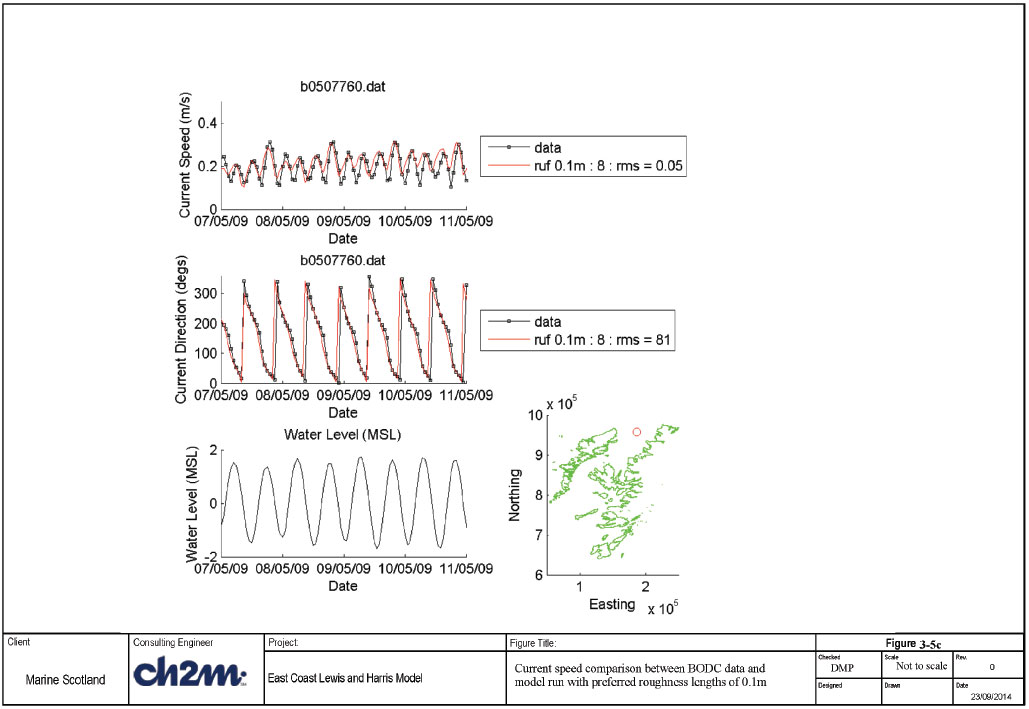
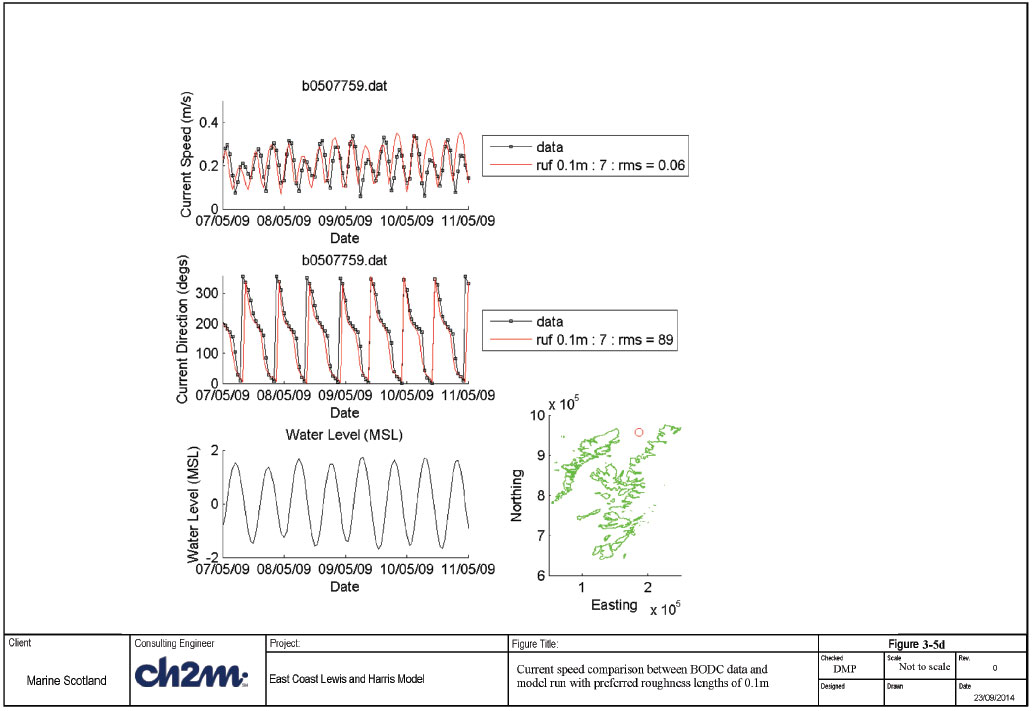
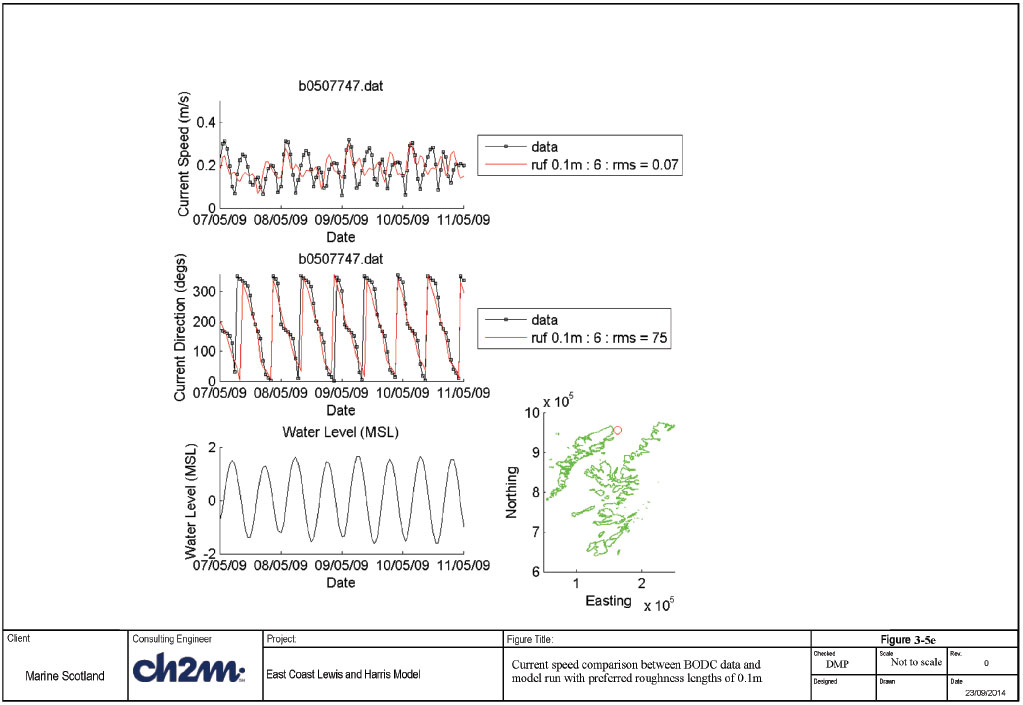
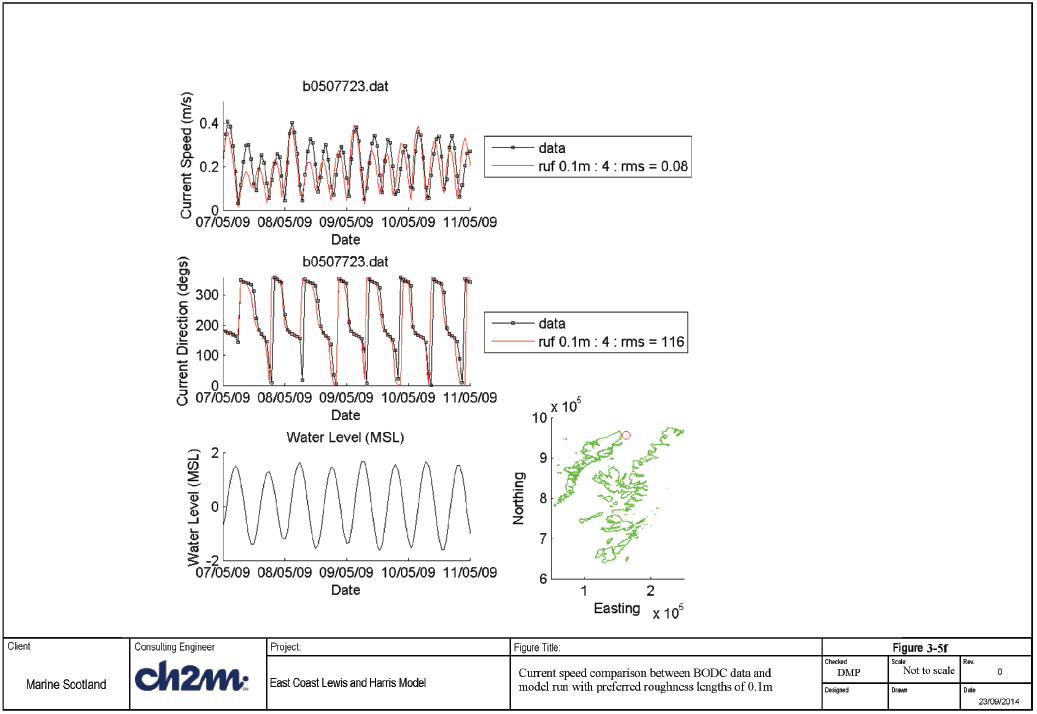
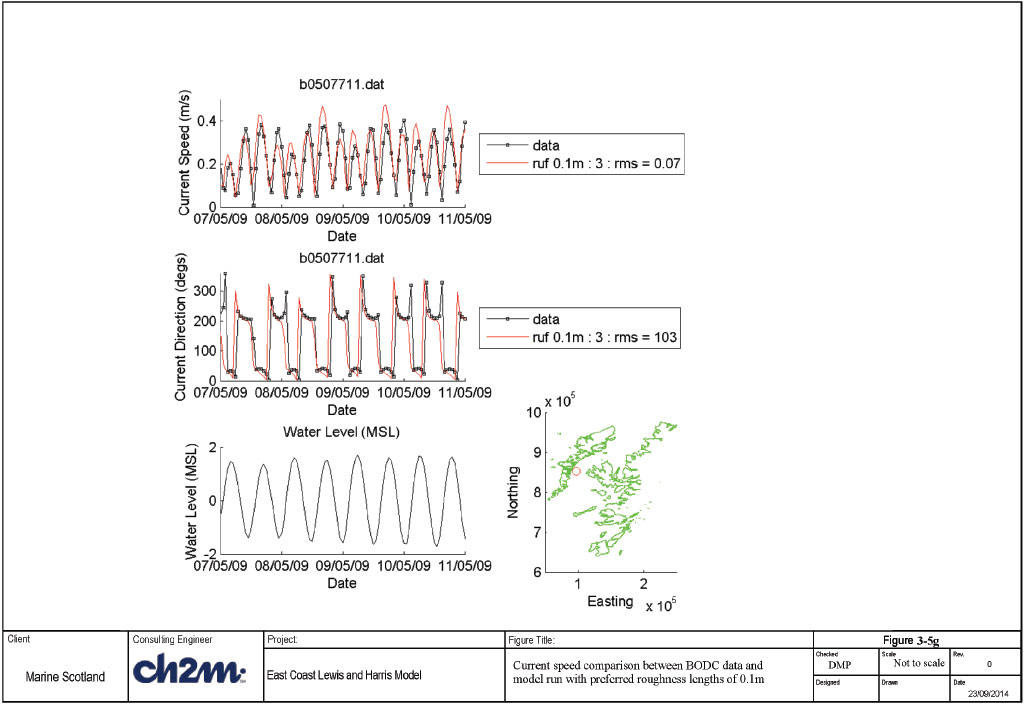
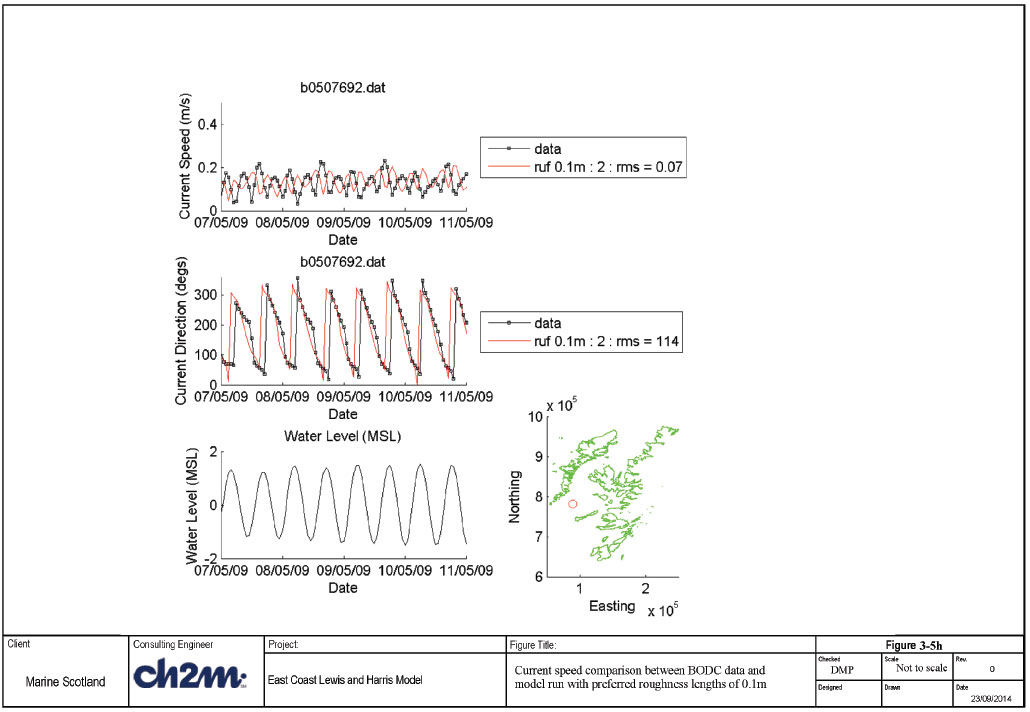
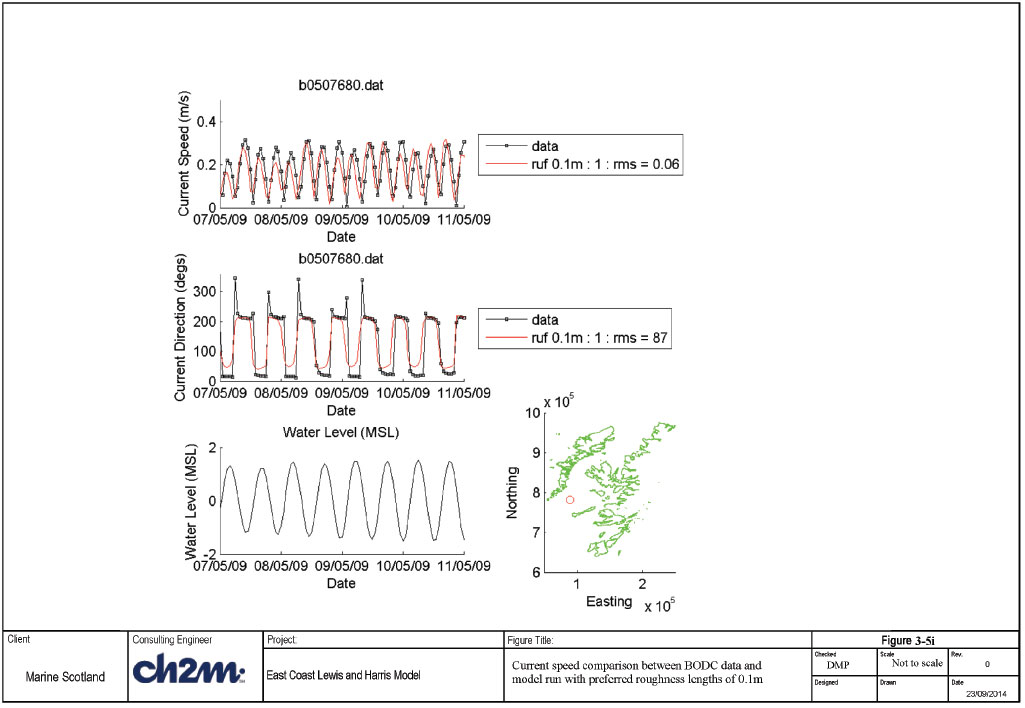
3.3.4.2 Comparison against Marine Scotland data
On 17-19 th May 2013, the MRV Scotia undertook a short survey recording current measurements at two location, one in the mouth of Loch Seaforth and the other further offshore in the Little Minch. The measurements were recorded using an ADCP the results of which were depth-averaged for comparison with the results from the 10 layer ECLH model. As boundary and met forcing were not available during this period of time, the results from a simulation for one month in May 2009 were harmonically analysed and reconstructed for the period that the data was collected for.
Figures 3-6a and b show the results of this comparison. Within Loch Seaforth entrance (Figure 3-6a) the magnitudes of the current speeds are reproduced well, being around 0.06m/s or lower. The speeds in the model however do drop lower than those observed, this could happen if the data is being influenced by wind and with such low current speeds the wind could create flows of a similar magnitude to the tidal flow. Apart from the beginning of the observed data, the flow is continuously flowing between west and northwards whereas the model does vary depending upon the phases of the tide with periods when the flow is southwards. This difference also suggests that wind may have been involved and coming from the south - southeast.
Figure 3-6b shows the comparison between the observed depth-averaged current speeds against the reconstructed model results in the Little Minch offshore from Loch Seaforth. The comparison here is not as good as would be hoped. On the late ebb tide when the currents are going in a southwest direction the model over predicts speeds.
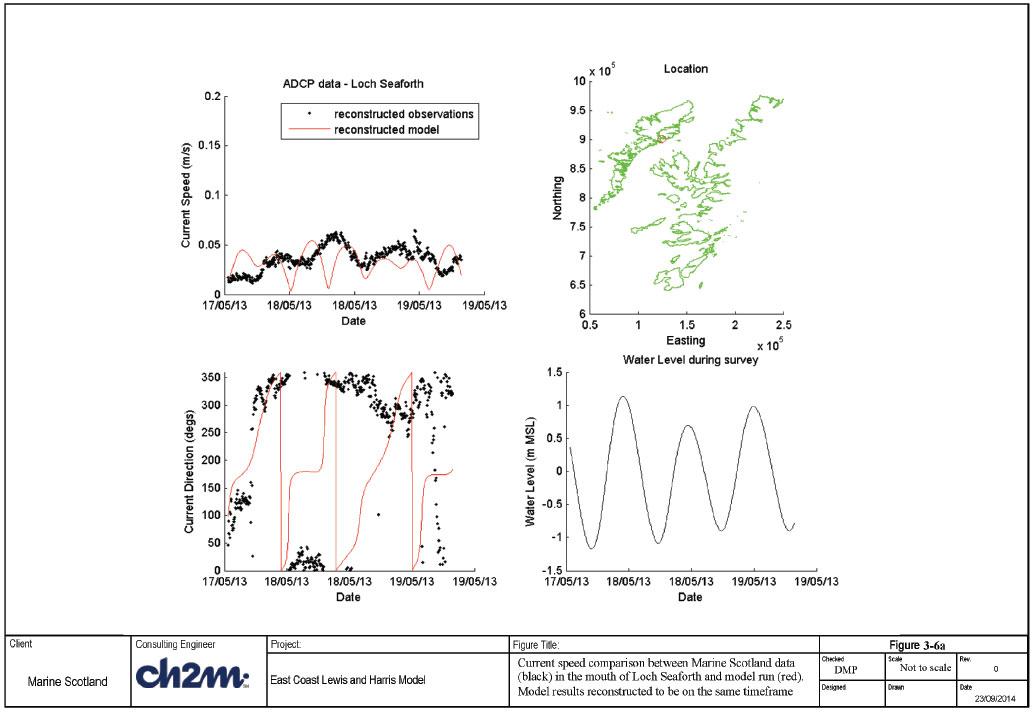
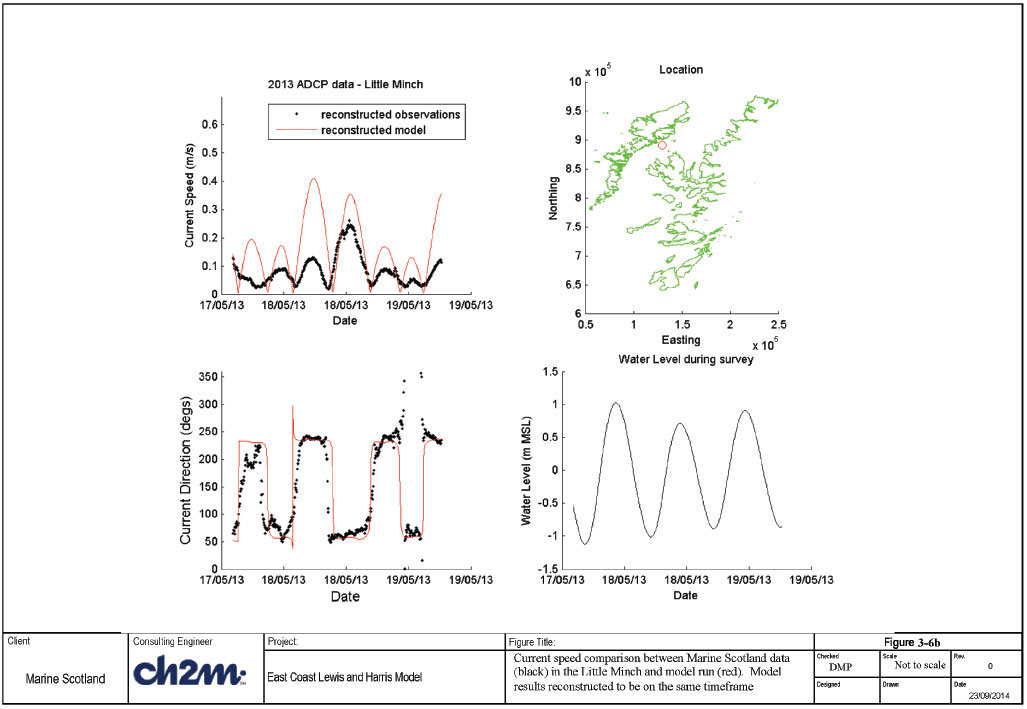
3.3.4.3 Comparisons against fish farm data
As mentioned previously, SEPA provided data from a large number of fish farms; a subset of these on the east coast of Lewis and Harris have been used for comparisons with the model results. Each dataset was recorded at different times for a minimum, of 15 days and therefore apart from the location presented in Section 3.3.4.2 there were no times coincident with boundary conditions or met forcing. Therefore a month long simulation of the baroclinic simulation from May 2009 was used to undertake a harmonic analysis of the model results as well as harmonic analysis of the fish farm data. Both sets of data were then reconstructed from the constituents to provide current speeds for a common time frame.
The results have been plotted as a scatter diagram of both the u and v components of the current speeds at the surface, mid -level and near bed representing the tidal ellipses at each location. It is these ellipses from the model and the data that have been compared against each other to check both the main direction and magnitude of the astronomical components of the local current regime.
The results are presented in Figures 3-7 a-h. In general the current speeds are very low in both the observations and model results with a good representation of these speeds and directions by the model. Figure 3-7a does not appear to provide as good a comparison as the other locations presented here. Other locations not included in this main body of the report can be seen in Appendix A.
At speeds of 0.1-0.2m/s, it is likely that wind could dominate surface currents, the raw data from the fish farm measurements showed much more scatter due to the effects of meteorological forcings.
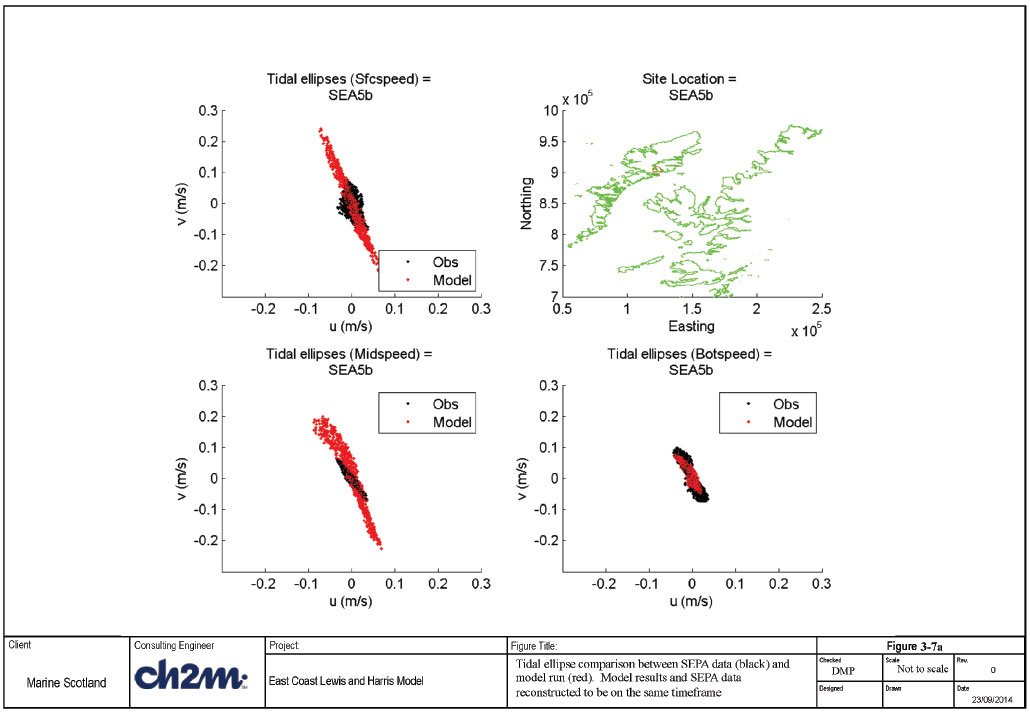
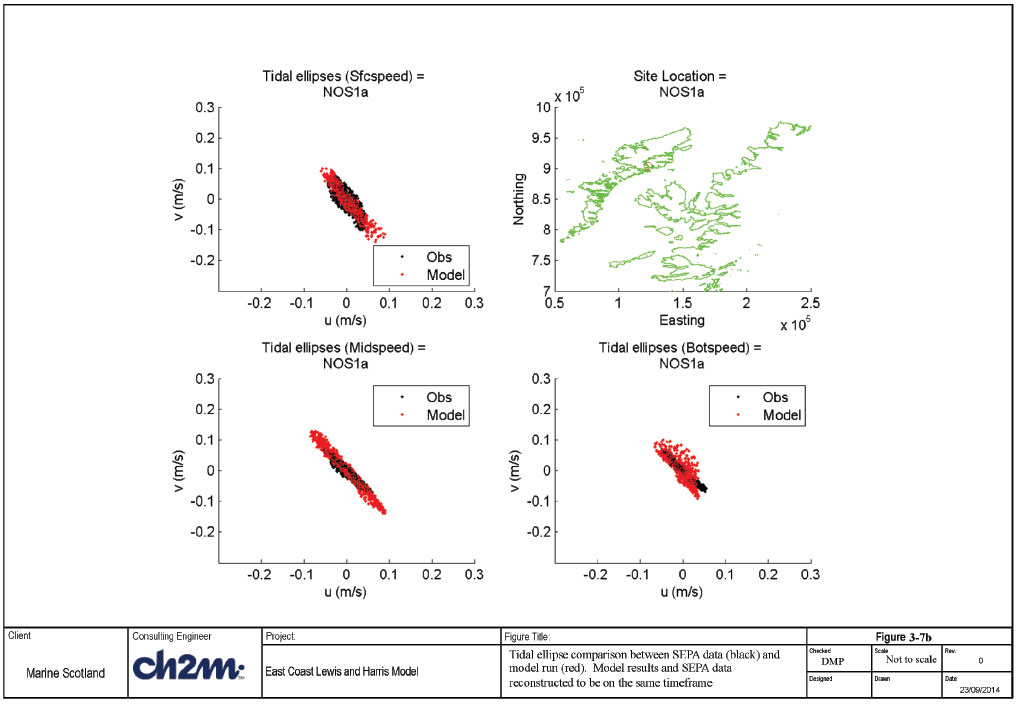
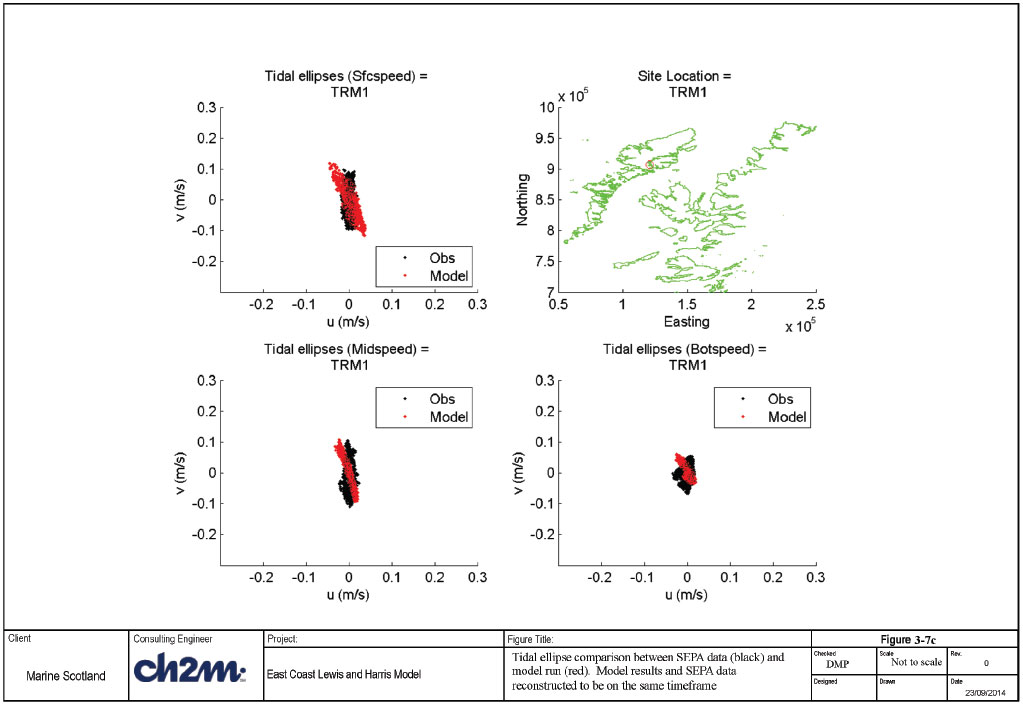
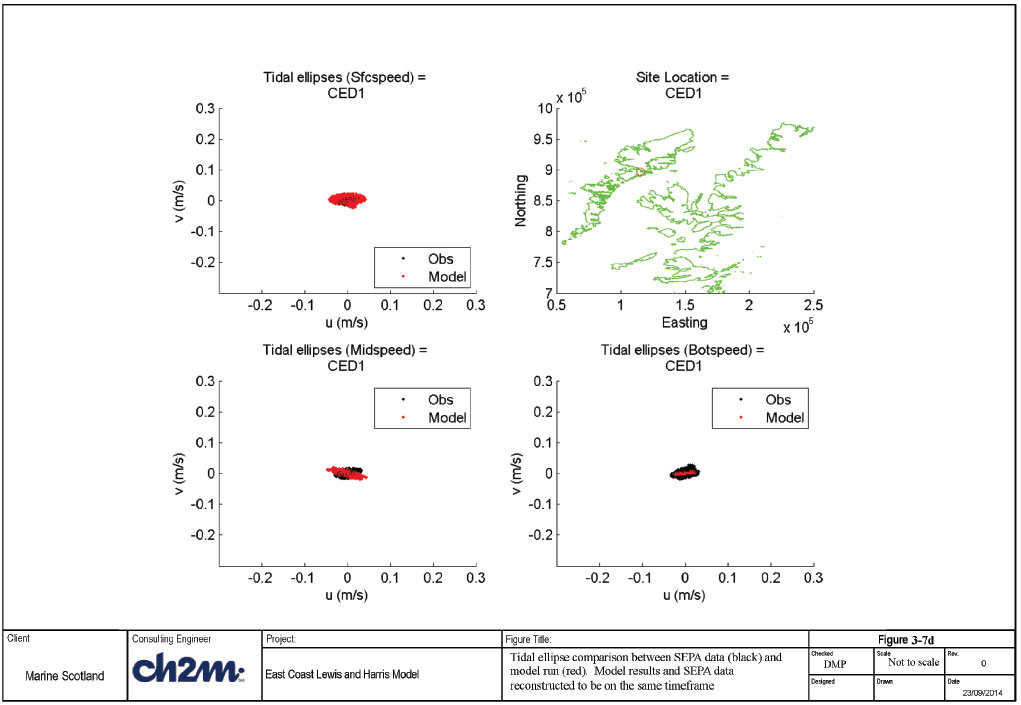
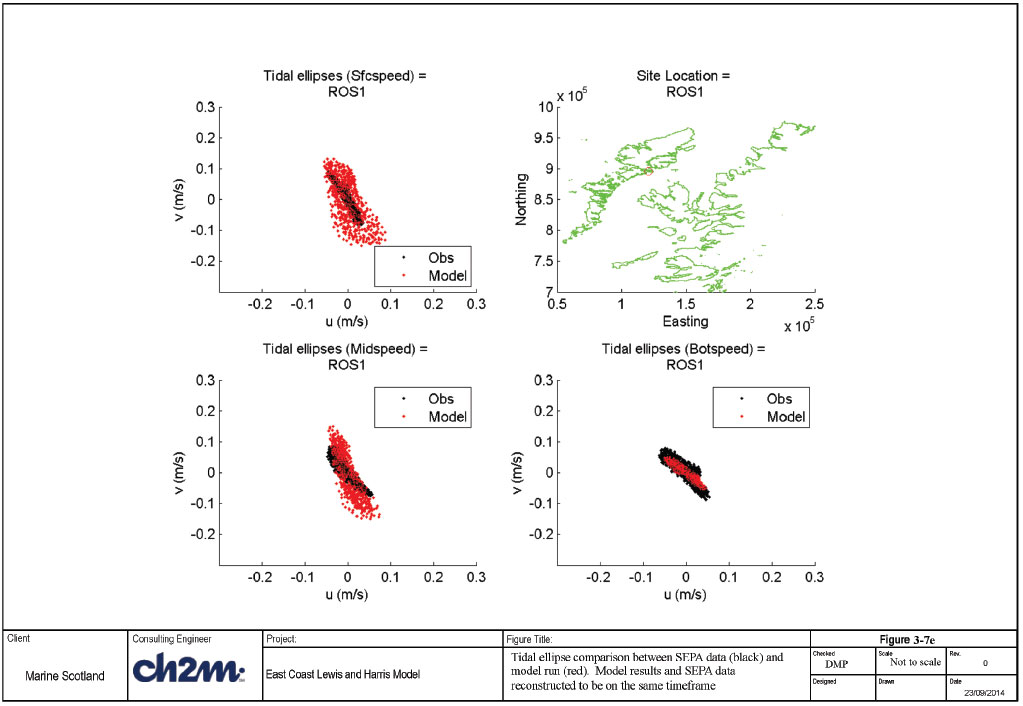
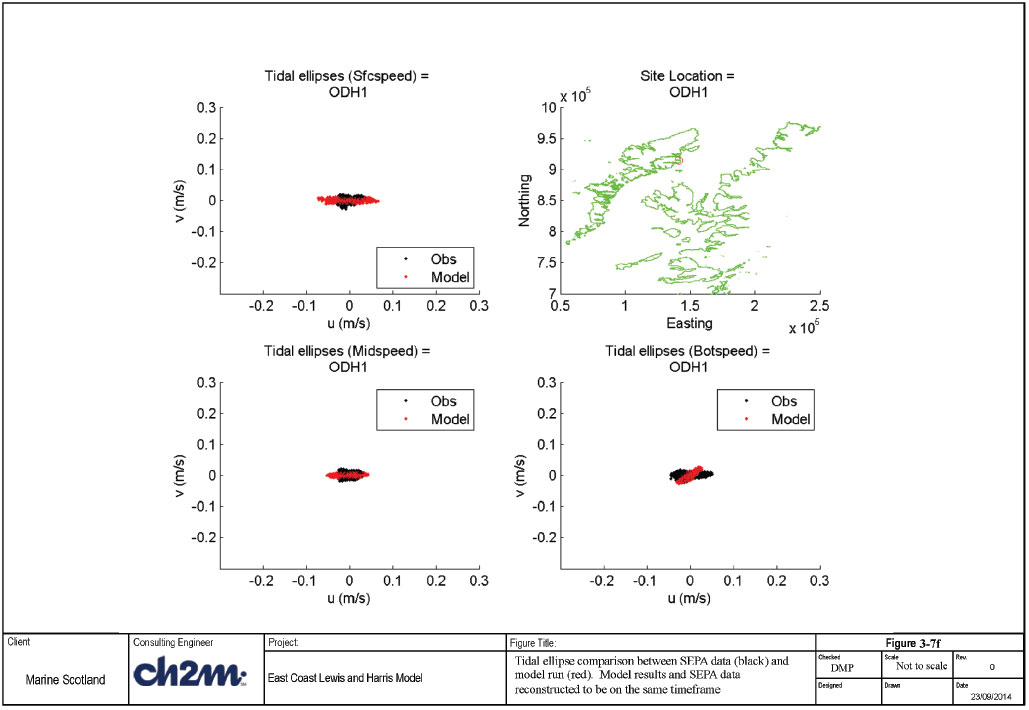
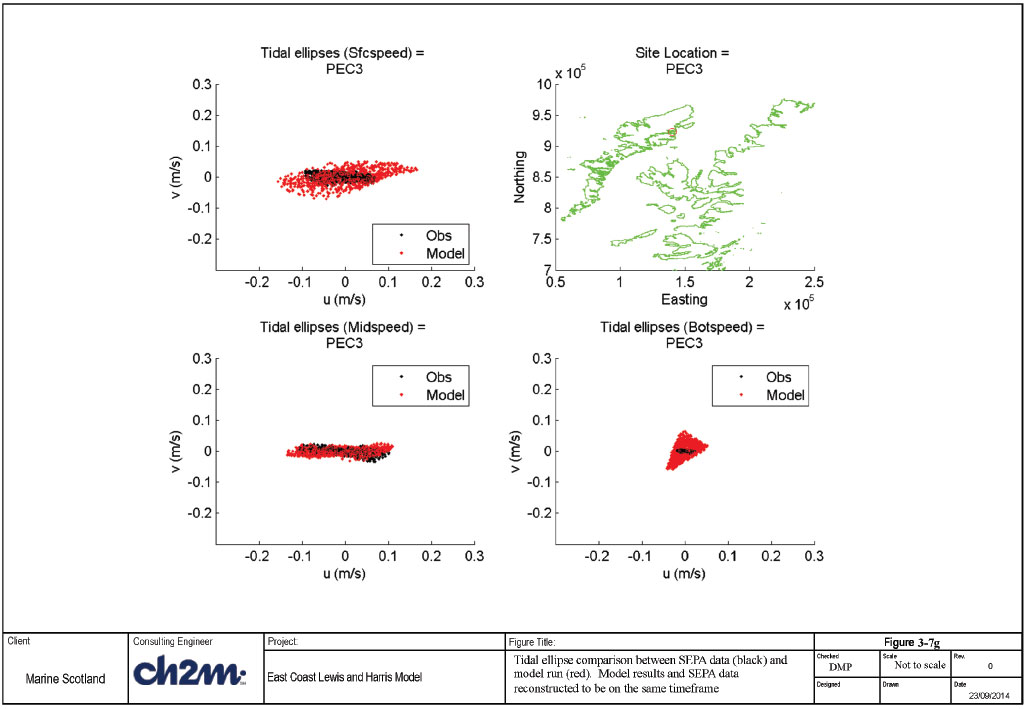
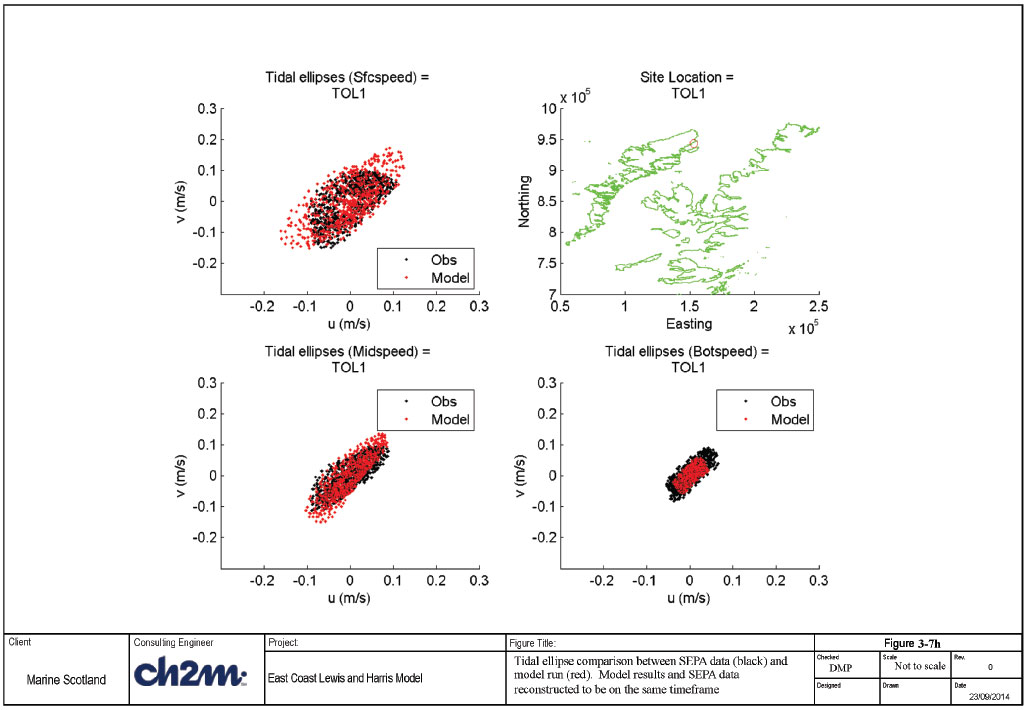
3.4.1 Introduction
Validation of modelled currents was carried out for July 2009 against measured fish farm current data. The temperature and salinity validation took place by running the baroclinic model (all met forcing and river inputs) for March 2009 when various vertical profiles were available for direct comparison.
3.4.2 Current speed validation
SEPA provided fish farm current speed data which had been recorded at a large number of locations around Scotland as part of the fish farm application process. Each data set consisted of near surface, mid depth and near bottom measurements of current speed and direction.
For many of these data sets, boundary conditions and met forcing were not available and therefore harmonic analysis and reconstruction was undertaken, as in the previous section. However for one location located off the east coast of Lewis (although it is towards the northern end) the period coincided with available boundary conditions, river data and meteorological forcing. Therefore the baroclinic model of the ECLH model was run to coincide with the period of the available data.
Figure 3-8 shows the comparison between the model and observed speeds and directions at the 3 depths. The near surface comparisons are on the top row and the near bottom are on the bottom row. The measurements are denoted with a black line and the model results with a red line.
It can be seen that in general the current speed comparisons are good with model and observed speeds generally less than 0.3m/s near to the surface and less than 0.2m/s at lower levels. RMS errors are 0.06m/s close to the surface and 0.05m/s at the lower levels. A visual comparison suggests that the model results are closer at the mid depth that at the others. The comparison is reasonable given the low current speeds. Another factor that may be affecting the results is the relatively coarse wind data used compared with the location of the data close to land and a loch. Local wind conditions may play a part in some of the differences observed.
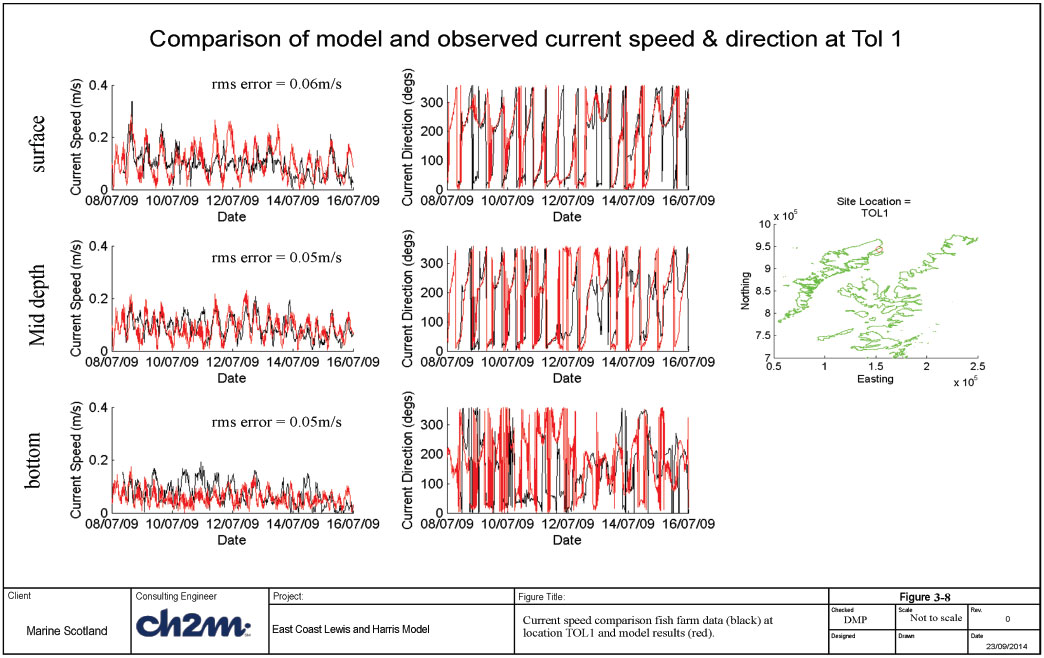
3.4.3 Comparison of baroclinic model results against vertical temperature and salinity profiles
The ECLH baroclinic model has included freshwater river flow input using data provided by CEH. Temperature and salinity daily data from the AMM model was applied at the nested boundaries as well as being used as initial conditions with which to start the simulation to reduce warm-up periods. Additionally it includes the internal calculation of heating (HEATING_CALCULATED is turned on in the model) within the model as well as wind, evaporation, precipitation and air pressure.
Vertical profile data was available in March 2009 throughout the model area and was obtained from the BODC archive. Therefore the Baroclinic model was run for a period during this month using the corresponding forcing information from the AMM model, river inflows and meteorological forcing.
The results from the model are presented in Figures 3-9a-h in the form of vertical profiles of salinity (top left frame), temperature (bottom left frame), location (top right) and tide curve with the time of the measurement highlighted (bottom right). Other locations not included in this main body of the report can be seen in Appendix A.
The observed data is shown with black lines, and the model results in red. It can be seen that the model simulates the temperature through the depth well, with differences being less than one degree and generally in the order of half a degree.
Salinity results from the model are at times a very close match, but at other times/locations there is up to a 1psu difference with the model predicting slightly lower salinities although closer to the bed the difference is reduced.
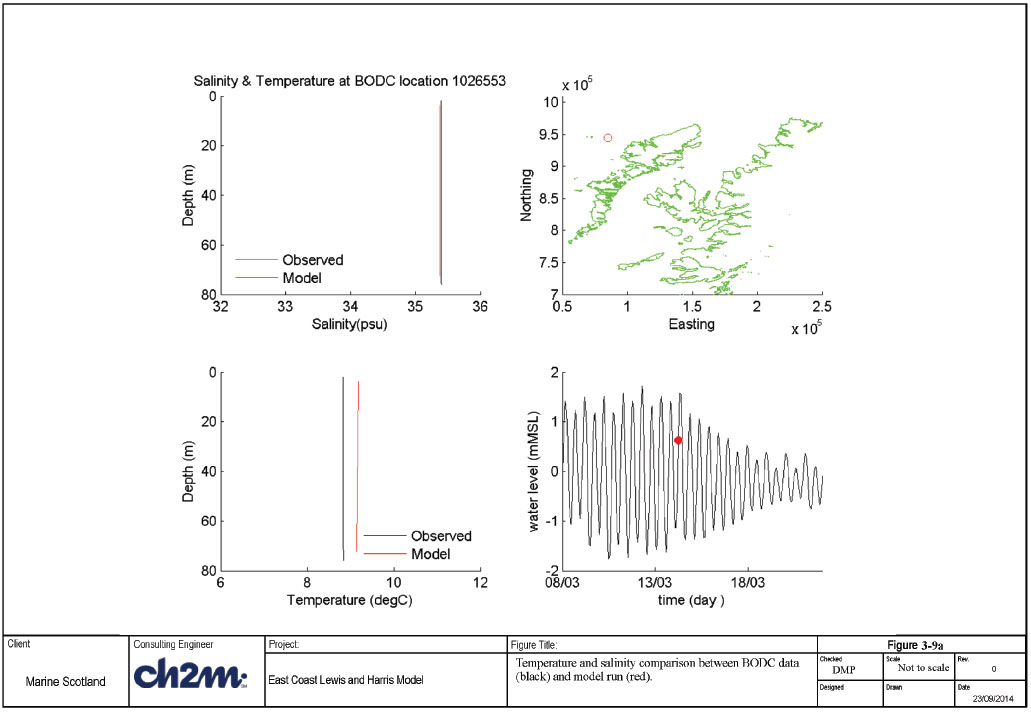
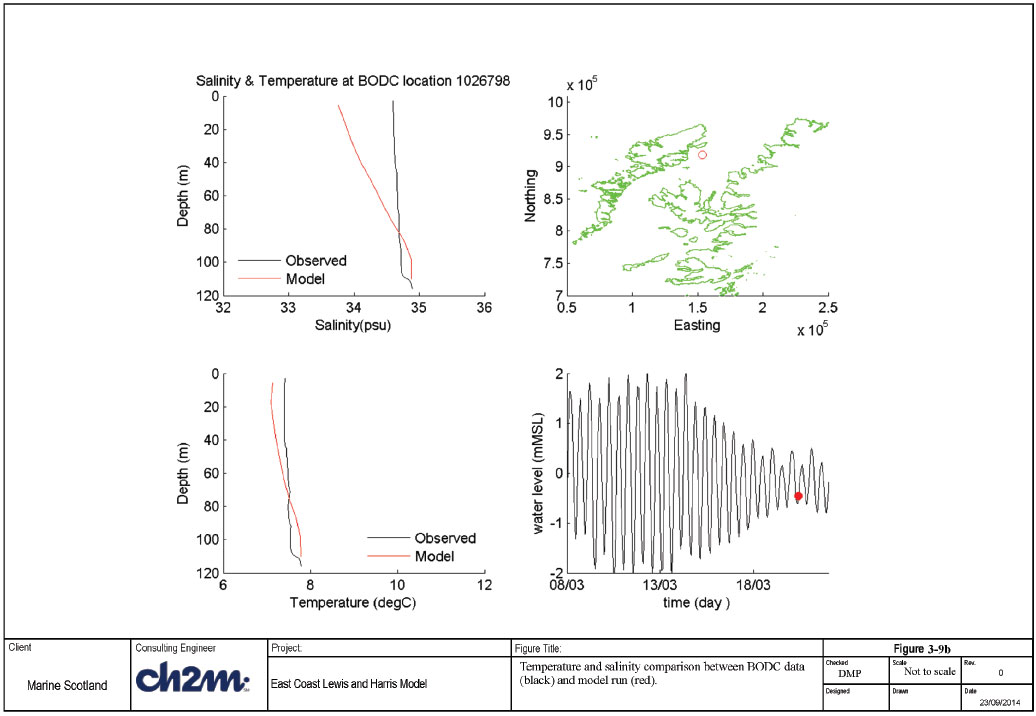
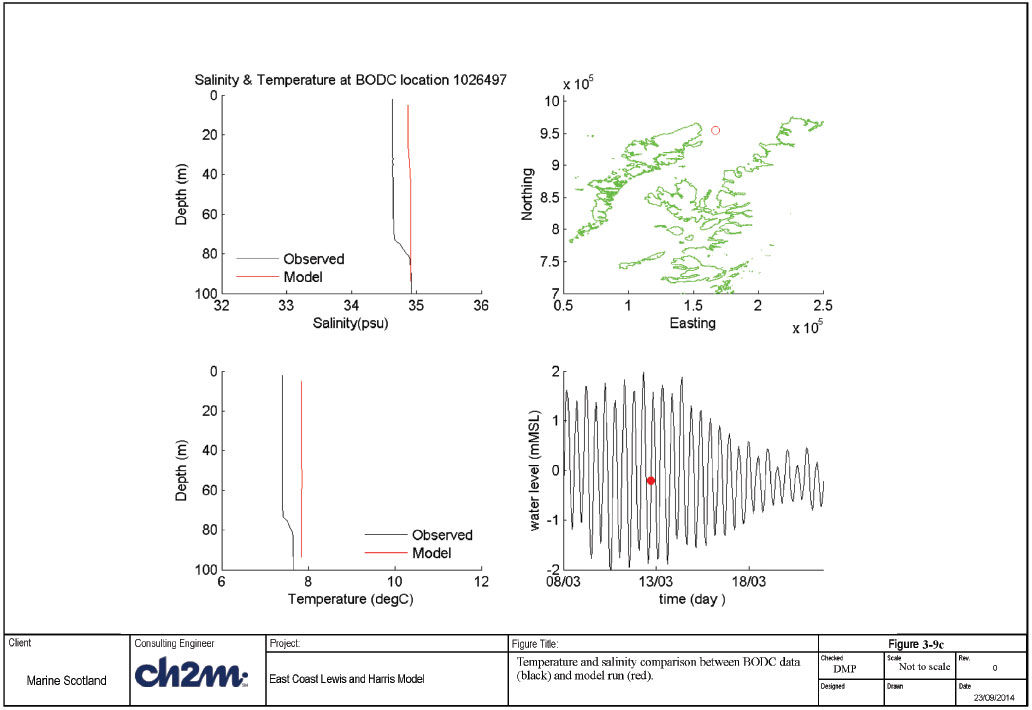
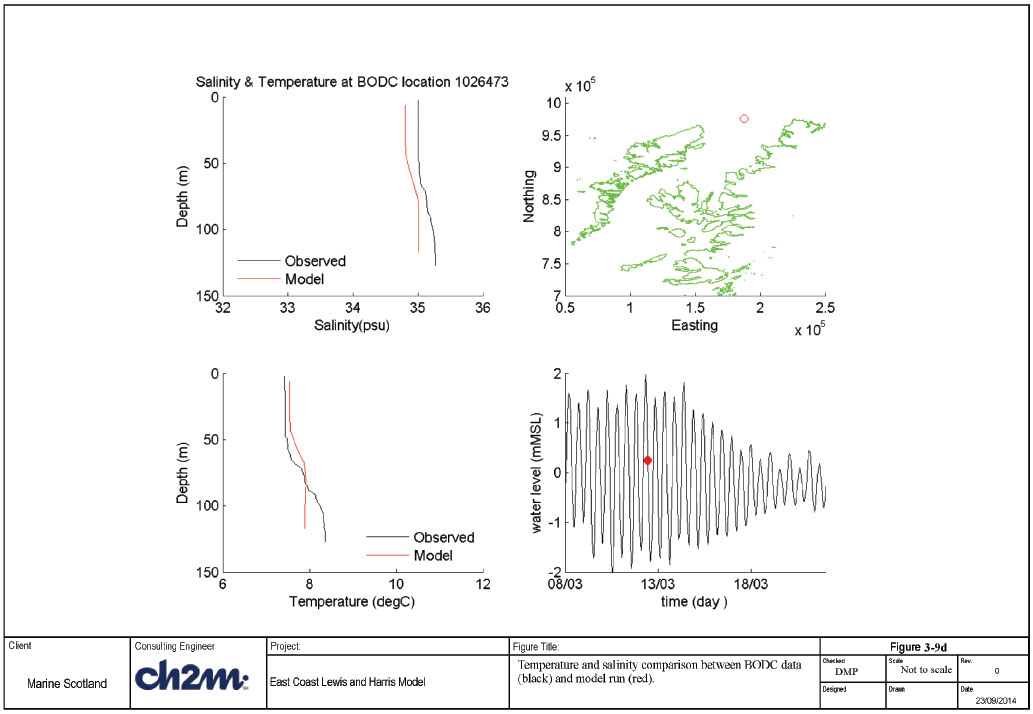
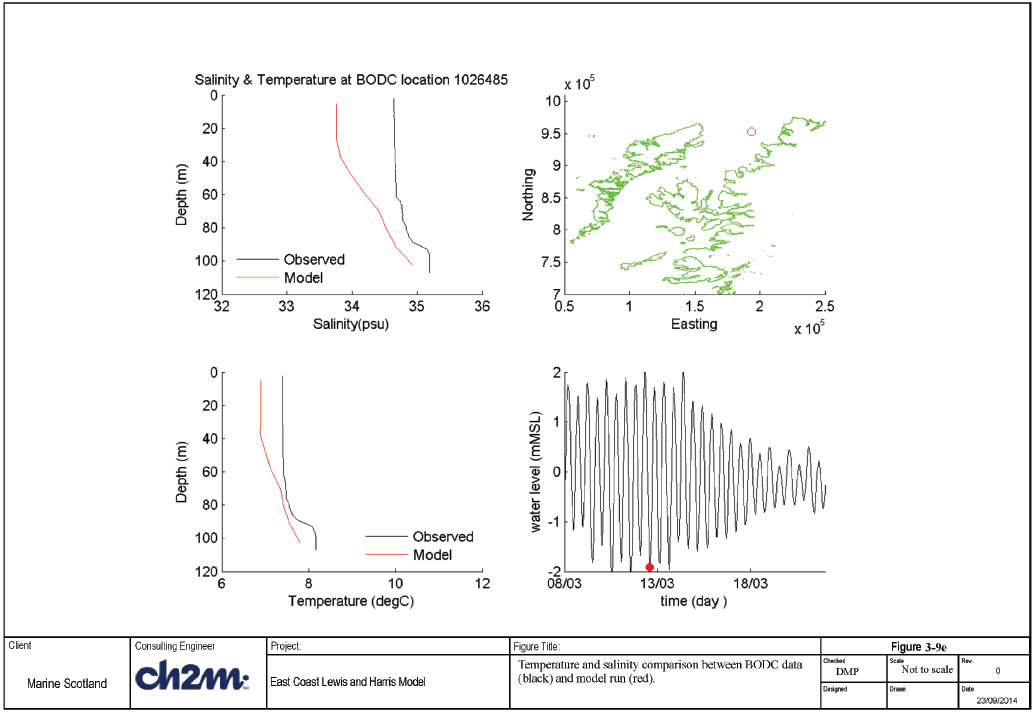
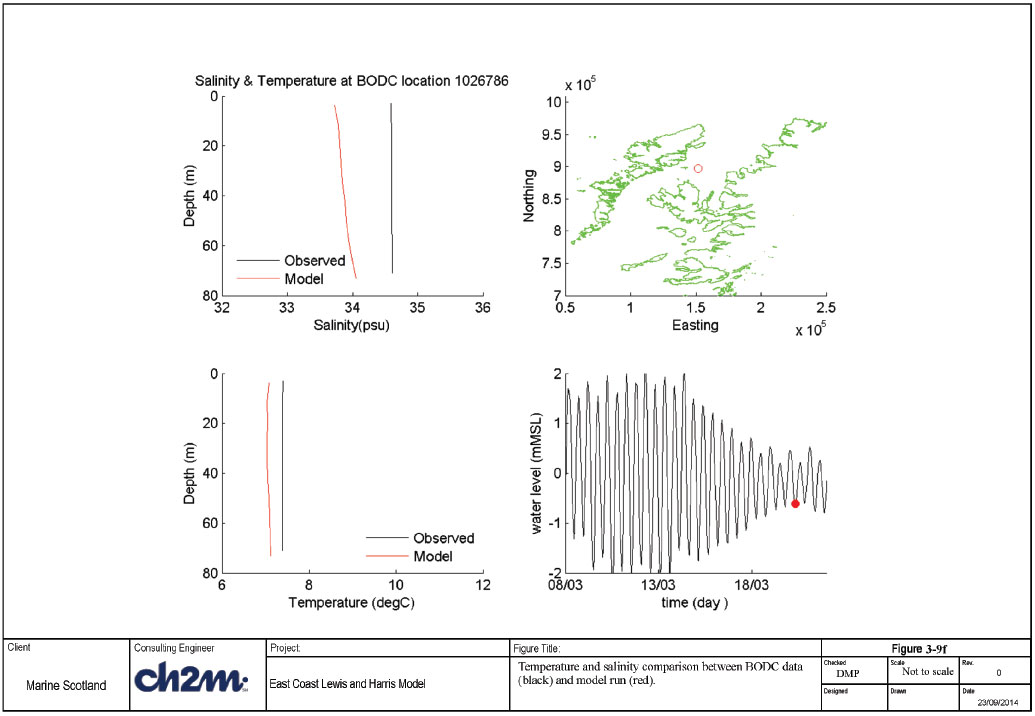
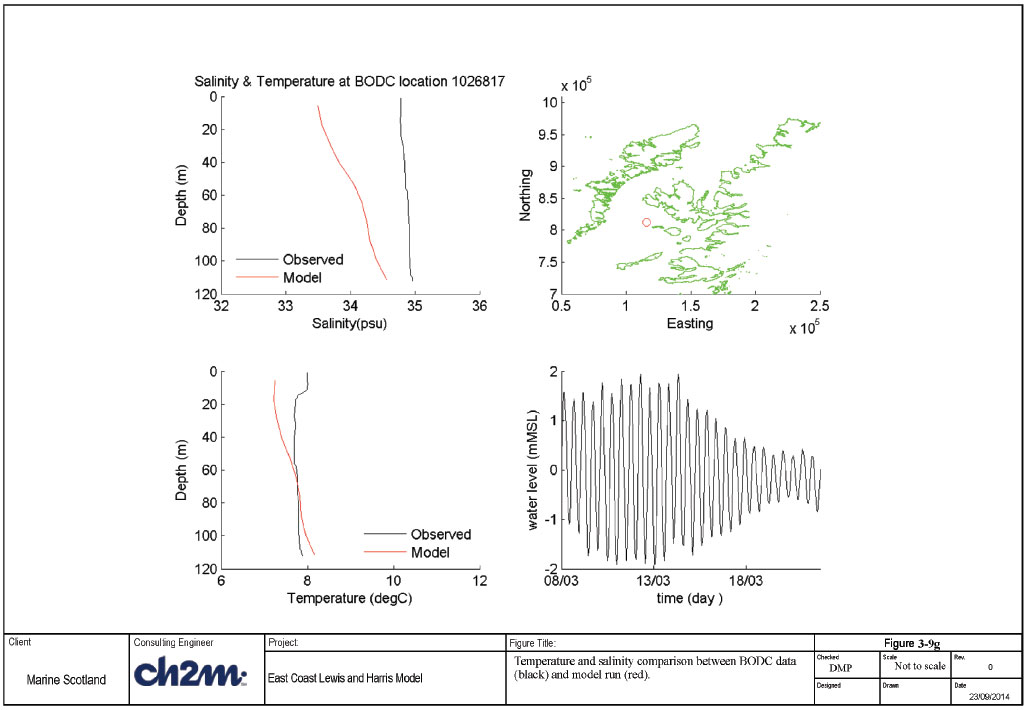
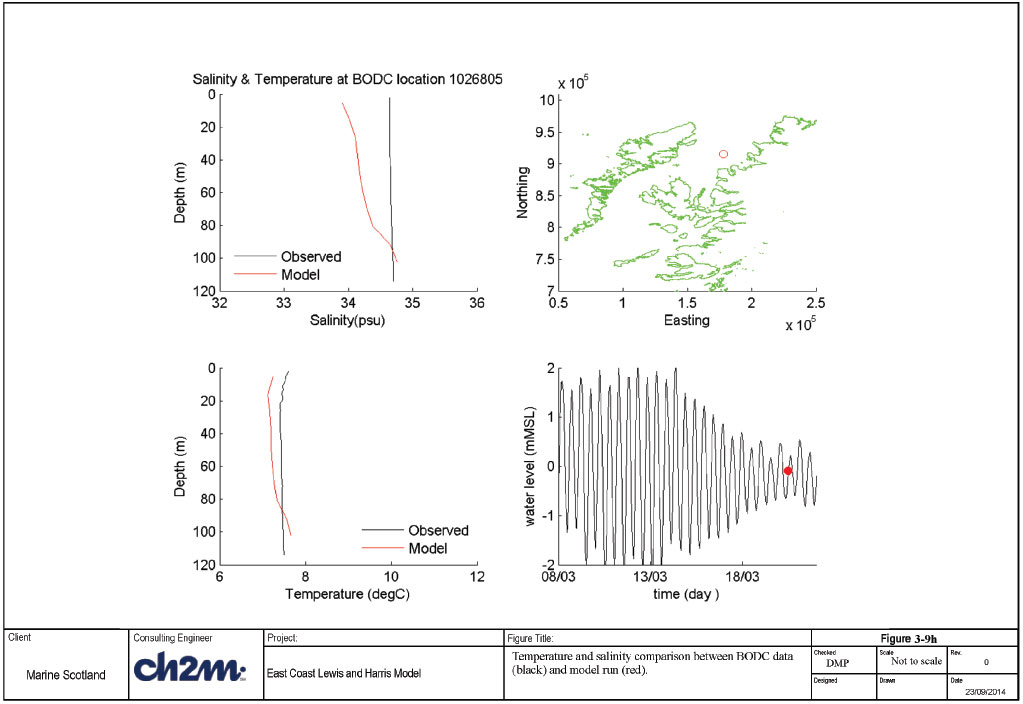
3.5 Summary of ECLH model calibration and validation
The ECLH model was initially setup to run with water level boundaries only. However as with other case study models within this project, there were numerous problems with instabilities which led to the use of nested boundaries. The type 2 nested boundary was used for this purpose, with water levels prescribed in a separate file to the velocities and temperature/salinity. This improved the stability of the model and allowed an external timestep of 3 seconds and an Isplit of 3 (therefore internal timestep = 9 seconds).
The boundary data used for the model calibration/validation stage came from the AMM model. However, for the climatological runs boundary data from the Scottish Waters Shelf Model developed under Stage 1 of this study are used.
The results in this section present comparisons between results from the ECLH model and observed data. In general, the model is able to reproduce current speeds and water levels within the guidance targets as well as the temperature being reproduced within 0.5 degrees and the salinity within 1psu. Therefore the model has been deemed to have been calibrated to a sufficient level to be taken forward for use with the climatological forcing. This is presented in the next Chapter.
3.6 Flow model simulations
3.6.1 Introduction
This section of the report describes the climatology runs of the flow model. The model set up used has been described in the calibration section. The requirement was to produce a six month run, from May to October, based on climatological forcing. This run was carried out using the Scottish Shelf model climatology results as initial conditions as well as for boundary conditions. The climatological input data sets for meteorological forcing and river fluxes used in the Shelf model were also used for the ECLH model. For a full description of the input data, the sources and how it was processed for climatological runs see the Scottish Shelf Modelling report, (Wolf et al. 2015)
The results from the climatic run have been compared with climatological atlas information for temperature, salinity and currents. The neap and spring tidal ranges and peak flows are also compared with the ABPmer tidal atlas.
The model results provide a distribution of the typical tidal and residual currents over ECLH which is used for particle tracking and to develop connectivity indices.
3.6.2 Climatology input data
3.6.2.1 Boundary conditions
Mean boundary forcing for water levels (mean yearly tides), currents, temperature and salinity were taken from the Scottish Waters Shelf model climatology results. Hourly results were interpolated on to the nested boundary nodes and elements using a Matlab script. Because the shelf model was run with 20 layers whilst the ECLH model has been run with 10 layers it was also necessary to average the current components, temperature and salinity from 20 to 10 layers. This was also carried out in the Matlab script.
3.6.2.2 River input
River climatology data was processed by NOC-L from G2G river climatology (1962-2011, 577 rivers) provided by CEH. For full details of how the river data was reconstructed to give climatological daily averages see the Scottish Shelf Modelling Report (Wolf et al. 2015).
Only 155 of these rivers fall within the ECLH model domain. The rivers were processed in the same way as those for the baroclinic calibration model runs. Figure 3-10 shows the location of the rivers and the location of the nodes the rivers were applied at.
3.6.2.3 Meteorological forcing
Met forcing data for the climatological simulations were interpolated on to the ECLH mesh from the Shelf model met forcing input files at 6 hourly intervals. The met forcing was derived by the NOC-L from ECMWF (ERA-40 and ERA-Interim, licence granted). The ERA-interim data cover 1989 - present, and ERA-40 1957 to 2002. These data were processed to derive monthly mean wind-stress, pressures, heat flux and evaporation minus precipitation for the period 1981-2010, to match the boundary forcing period.
The met forcing were derived as monthly means, which were then linearly interpolated to 6-hourly smoothed forcing data for each grid-point of FVCOM i.e. mean February data were applied at the middle of February; then mean March data were applied mid-March etc., with time-interpolation between. For full details see the Shelf Modelling report, Halcrow (2015).
3.6.3 Validation
3.6.3.1 Temperature and Salinity Comparisons
Average monthly sea surface temperature ( SST) and sea surface salinity ( SSS) observations are available from two sources:
1) The ICES dataset ( http://ocean.ices.dk/HydChem/HydChem/aspx?plot=yes) gridded and averaged for 1960-2004 (45 years) by Jason Holt. Data are also available from the NOAA/ NDBC World Ocean Atlas (2013);
2) The WOA (World Ocean Atlas) http://www.nodc.noaa.gov/OC5/woa13/) based on over 100 years of observations interpolated on to a 0.25° resolution grid.
These datasets are used for qualitative comparison with the ECLH FVCOM results for May, August and October. The results from the shelf model are also presented. Figures 3-11a-c shows the comparison of the data sets for SST. The comparison between the data sets is good for all months.
Figure 3-12a-c shows the SSS comparisons. The salinity close to land where rivers are discharging are lower in May than August and October due to the relative levels of rainfall and river discharge. The comparison between the data sets shows good agreement for all months.
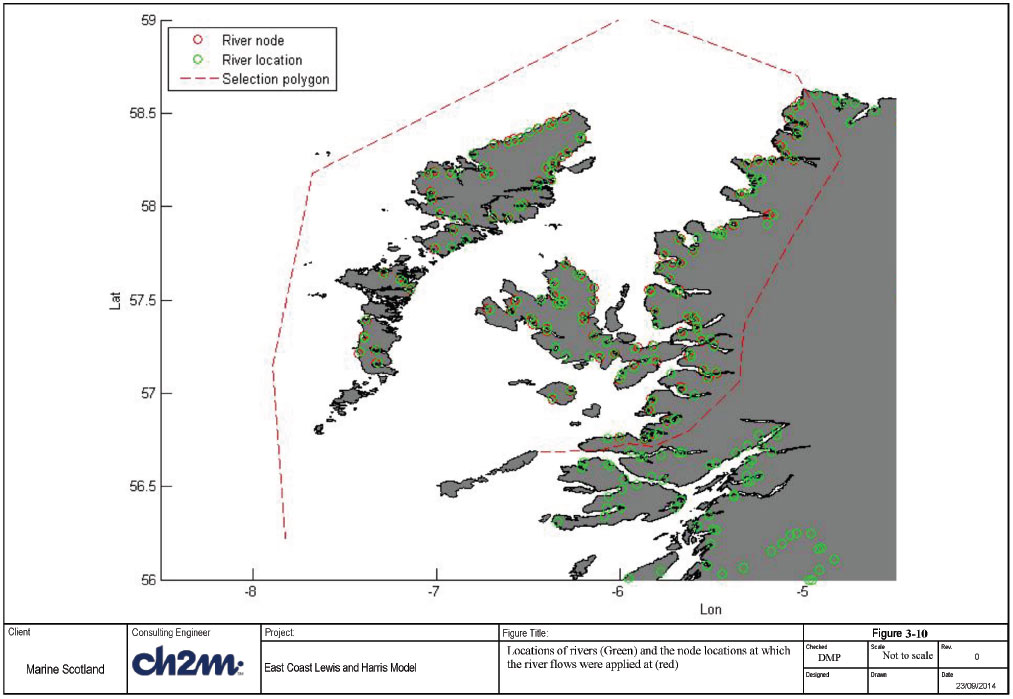
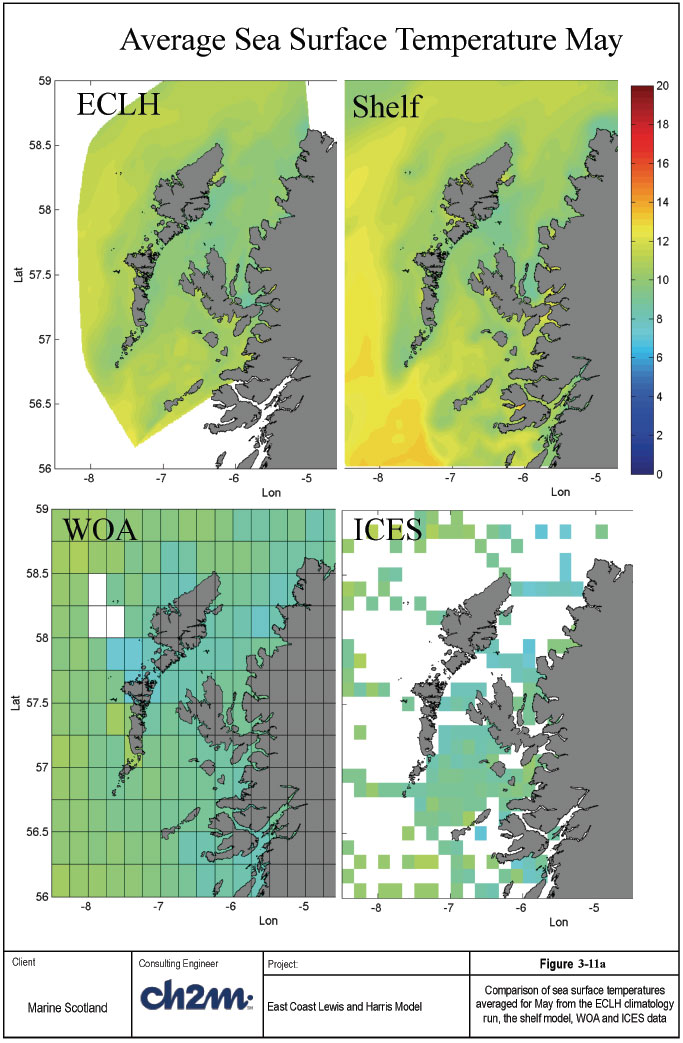
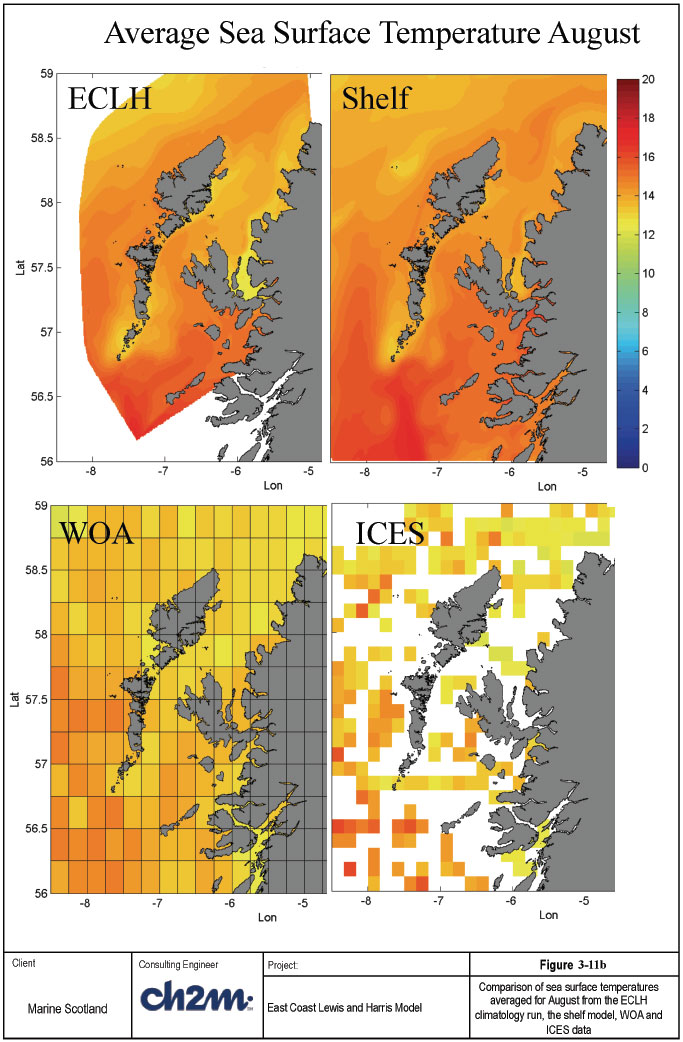
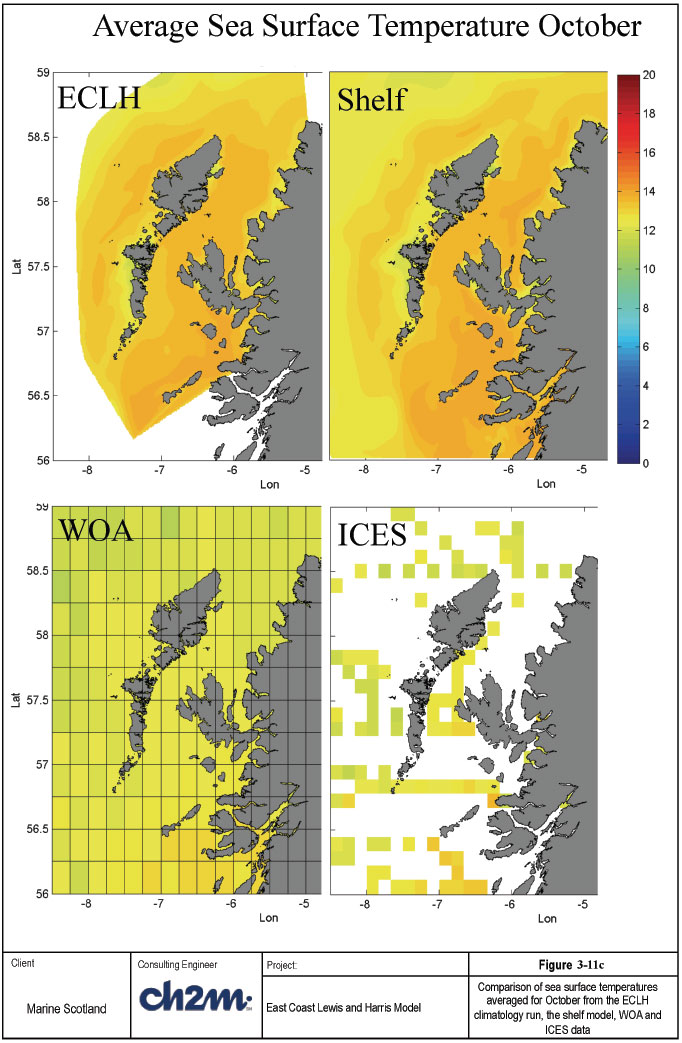
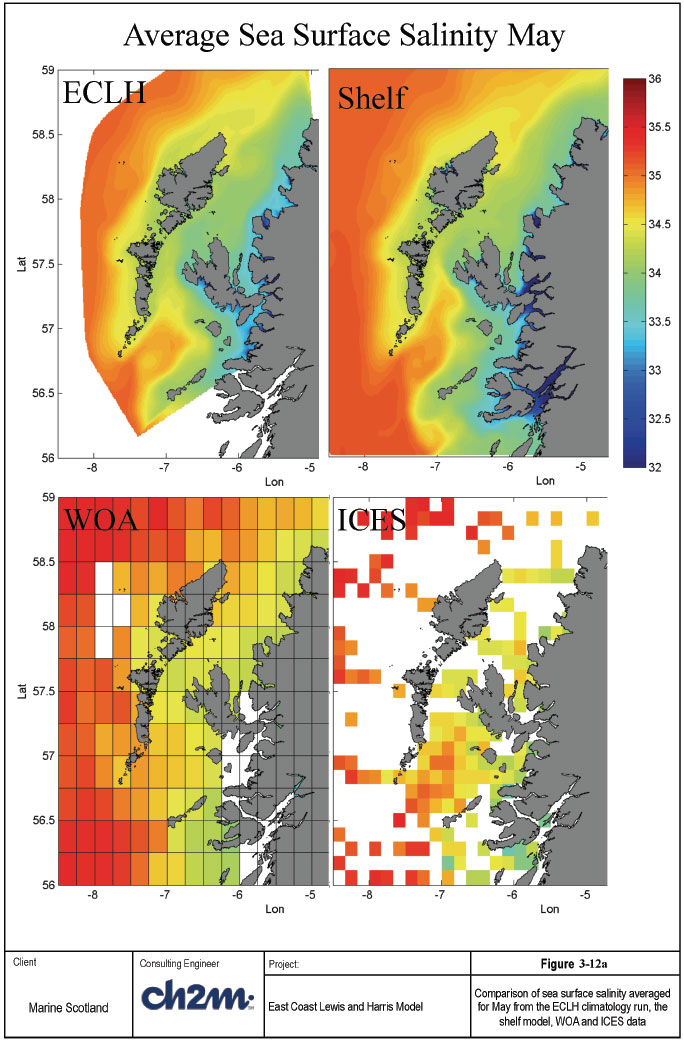
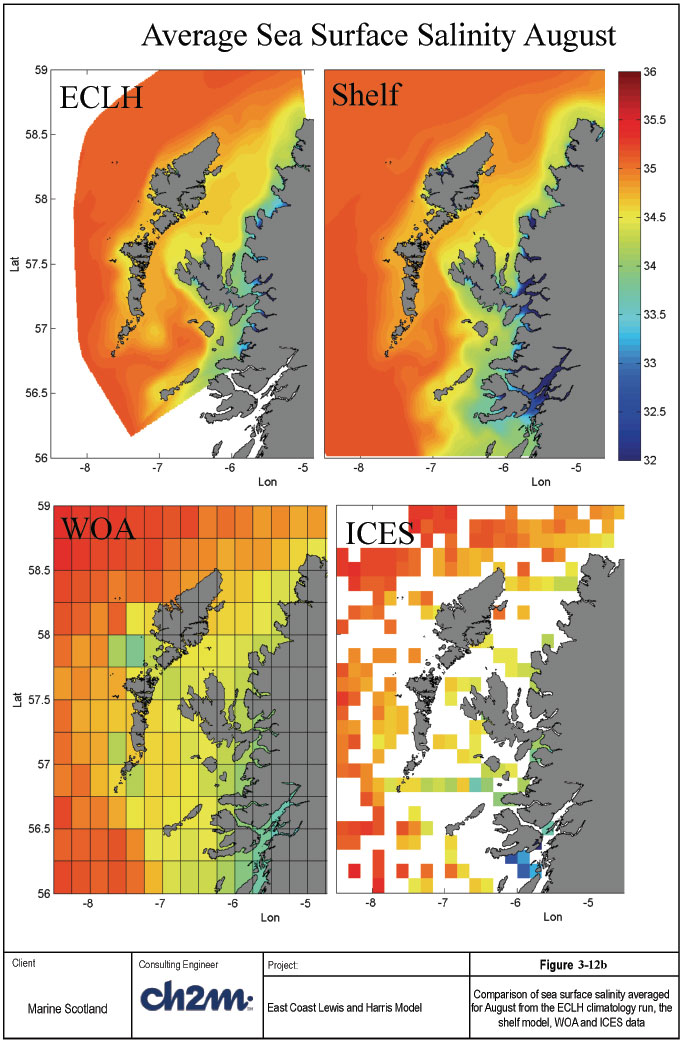
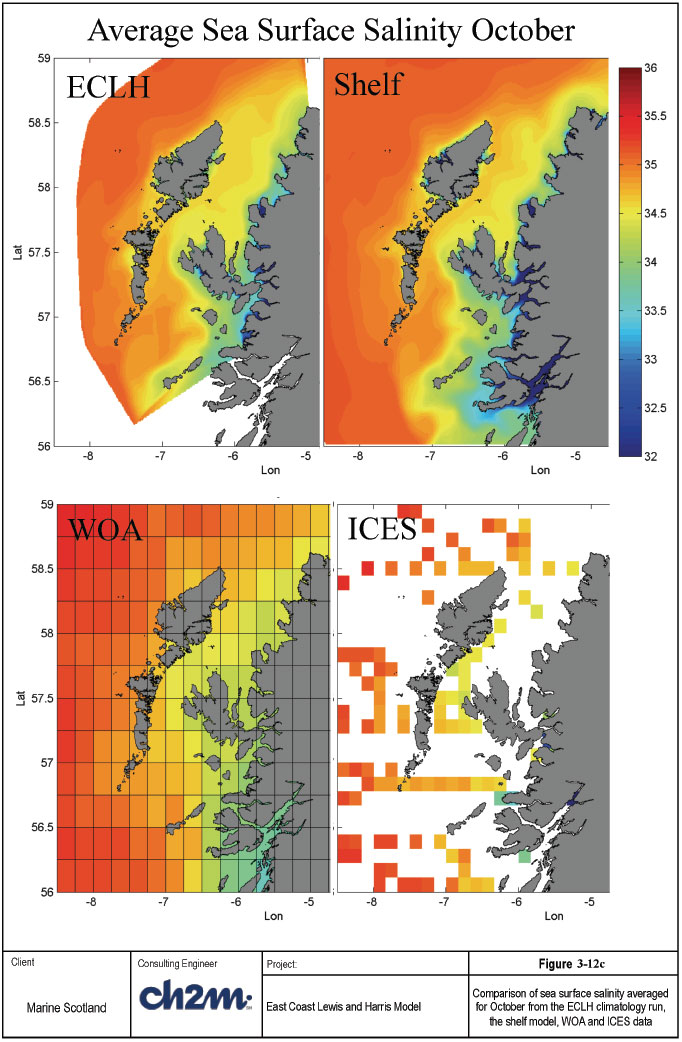
3.6.3.2 Mean Spring/Neap Tidal Range
Mean spring tidal ranges have been computed directly from the two principal semi-diurnal components M 2 and S 2 based on the following equations from Pugh (1987):
mean high-water springs = Z 0 + (H M2 + H S2)
mean low-water springs = Z 0 - ( H M2 + H S2)
spring tidal range = mean high-water springs - mean low-water springs
Values for these constituents were obtained from a harmonic analysis of 60 days' worth of data from the ECLH climatology run (01/05 - 30/06). These harmonic components control the timing of the spring-neap cycle, and their combination is considered to give a good measure of average spring (and neap) tides. The data was also used to calculate the mean neap tidal range as:
mean high-water neaps = Z 0 + (H M2 - H S2)
mean low-water neaps = Z 0 - (H M2 - H S2)
neap tidal range = mean high-water neaps - mean low-water neaps
A map of the mean spring results are shown, along with the equivalent tidal range from the ABPmer / NOC Atlas of Marine Energy Resources ( http://www.renewables-atlas.info/) in Figure 3-13a. The corresponding plots for mean neap tidal range are shown in Figure 3-13b. The spring tidal range from the ECLH FVCOM model is lower than that shown in the ABPmer tidal atlas in the area between the Outer Hebrides and the mainland. The comparison of neap tidal range in Figure 3-13b shows that the calculated tidal range is greater for the ECLH model. Further comparisons were made at a number of locations where the M2 and S2 constituents are available from the Admiralty tide tables (Figure 3-14a). Due to the lower resolution of the ABPmer model comparison was not possible at a number of points around the Kyle of Lochalsh. The spring tidal ranges from the admiralty charts support the results of the ECLH model at most locations (Figure 3-14b). Agreement is particularly good around the area of interest, i.e. Stornaway to Bays Loch, the ABPmer model tends to overestimate the spring tidal range. The neap tidal ranges at the admiralty locations are overestimated by both the ABPmer and ECLH models. However the comparison between the two models between East Loch Tarbert and Castle Bay (the east coast of the Hebrides) are good. (Figure 3-14c)
The differences between the two model results are likely to be related to the variation in the model resolutions. In the ABPmer model the Isle of Skye is attached to the mainland and the openings between the Hebridean Islands is not well resolved. In fact the tidal ranges calculated in the shelf model which also has Skye attached to the mainland compare well to the ABPmer model results (Wolf et al. 2015). This highlights the benefit of the nested ECLH model.
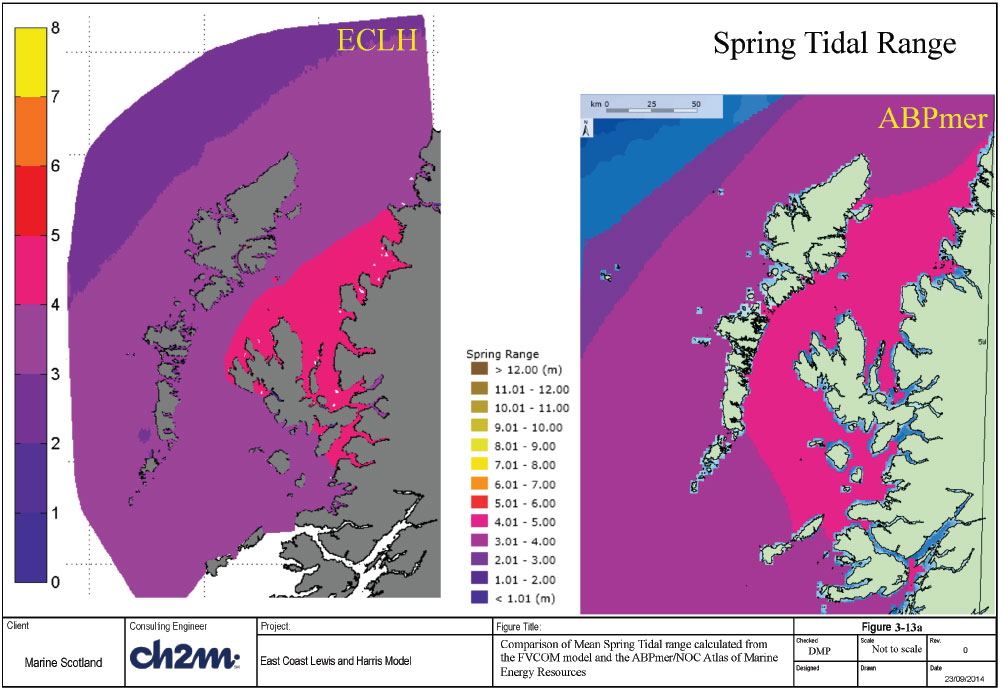
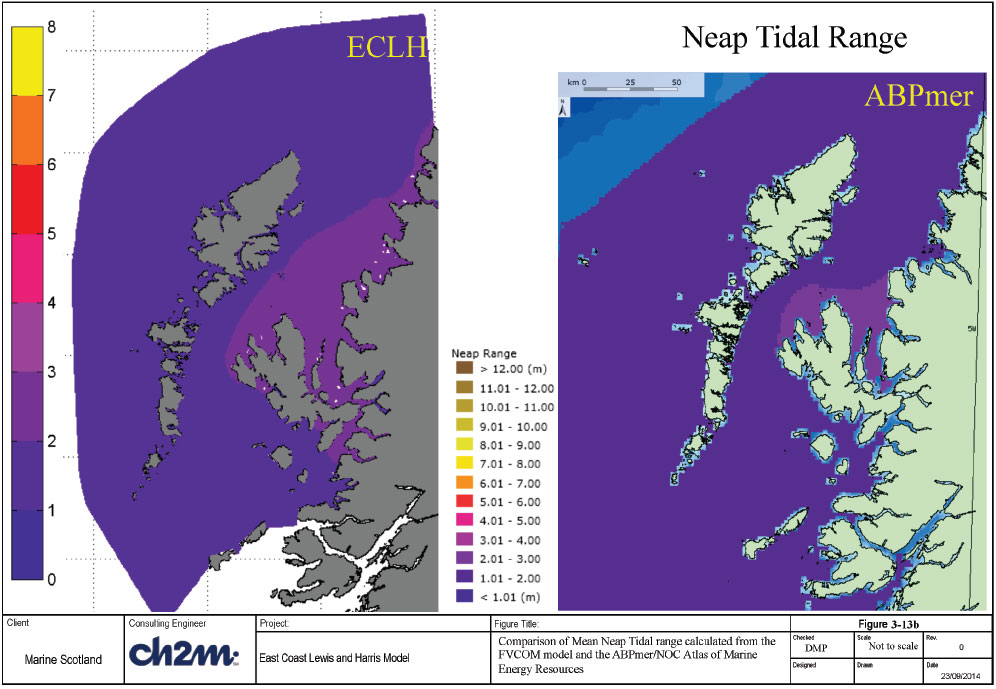
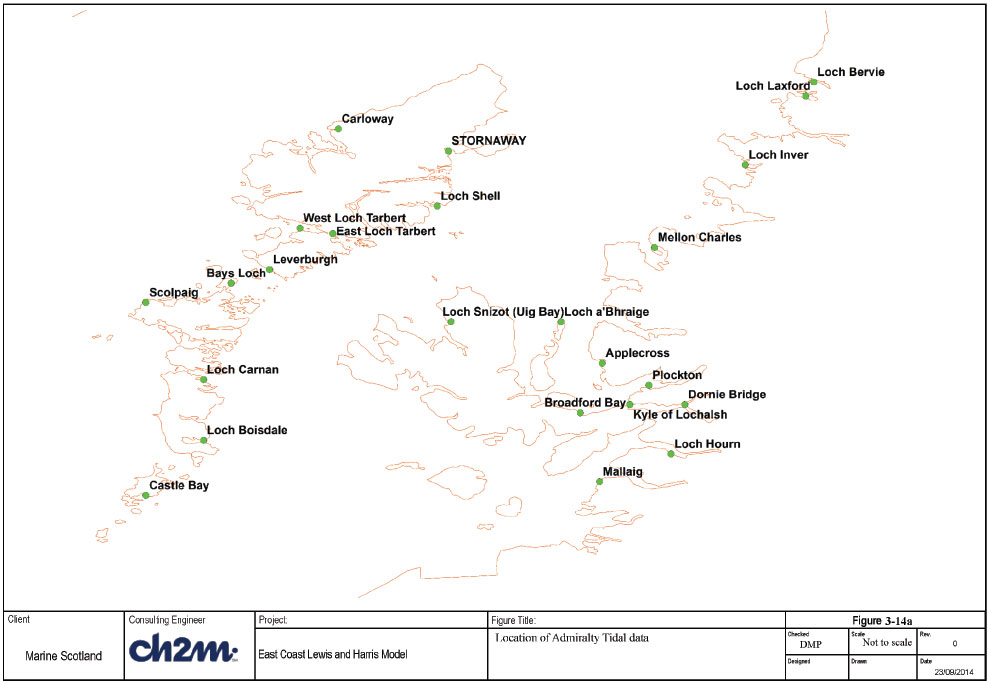
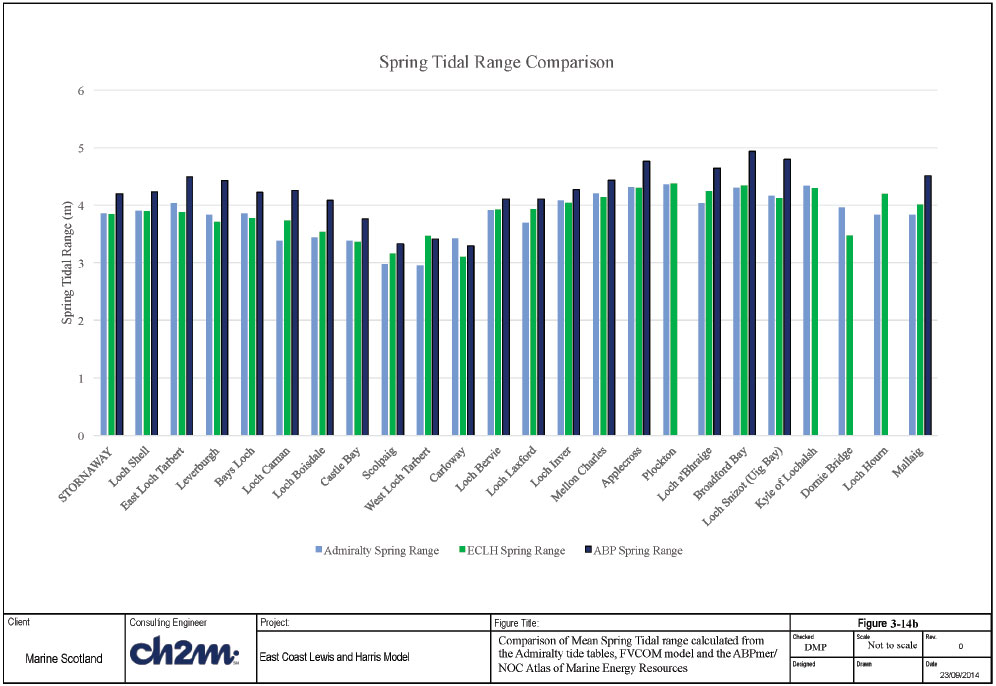
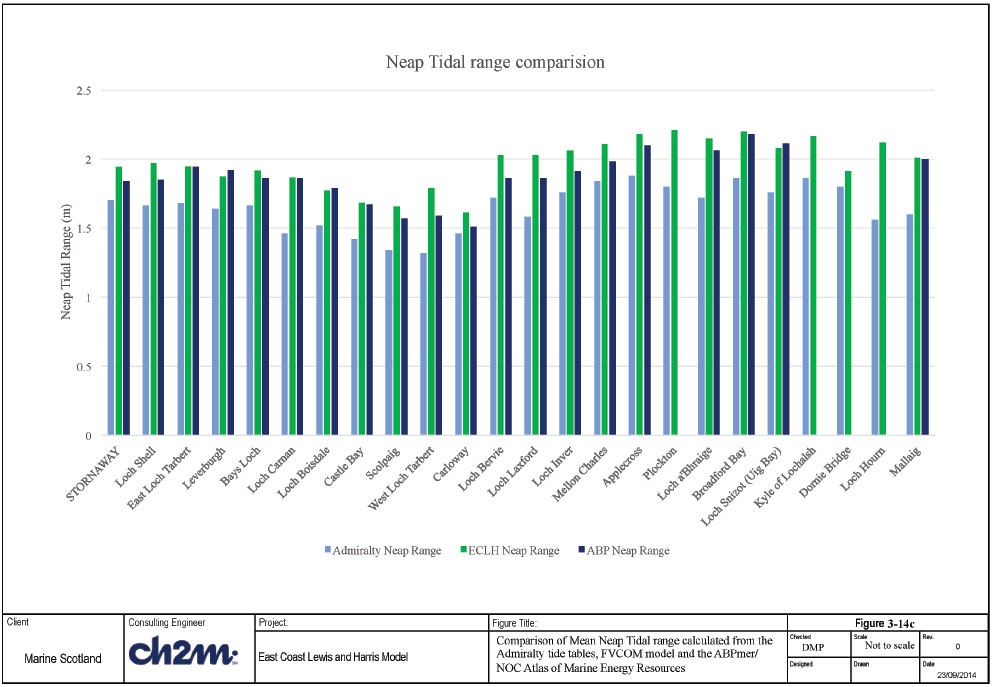
3.6.3.3 Mean Spring/Neap Currents
Mean peak current speeds have been calculated from a harmonic analysis of 60 days of depth averaged tidal velocities, from the ECLH climatology run (01/05 - 30/06. The east and west components of velocity were analysed using T_TIDE to give the M 2 and S 2 amplitudes and phases. These were in turn analysed to give the semi-major axis amplitudes for each ellipse. The mean peak spring current was then computed as:
mean peak spring current = amplitude semi-major axis M 2 + amplitude semi-major axis S 2
The mean neap spring current was computed as:
mean peak neap current = amplitude semi-major axis M 2 - amplitude semi-major axis S 2
A map of the results for mean spring current is shown, along with the equivalent peak currents from the ABPmer / NOC Atlas of Marine Energy Resources, in Figure 3-15a. Corresponding plots for the mean neap current are shown in Figure 3-15b. The peak spring flow data from the ABPmer Atlas is taken from a higher resolution model. The spatial variations in peak flow are consistent between the two data set however the ABPmer Atlas give higher values of peak flow, particularly at the southern tip of the Hebrides (Barra Head) and the northern tip of Skye. The neap peak flows from the ABPmer Atlas are from the lower resolution model (Figure 3-15b). There is good agreement between the CH2M and ABPmer data sets for neap peak flows, again the ABPmer data gives higher peak flows at the northern tip of Skye.
3.6.4 Results
The channel between the Outer Hebrides and the Scottish Mainland known collectively as the Minch is an area with complex topography and a complex coastline shown in Figure 3-16. The North Minch is separated from the sea of the Hebrides (referred to as the South Minch in this report) by the Little Minch. This area has complex hydrodynamics, influenced by the interaction of three water masses: 1) High salinity (>35.0psu) Atlantic water, 2) Low salinity (<35.0psu) Irish and Clyde Sea water transported northwards by the Scottish Coastal Current and 3) fresh coastal water derived from river runoff from the Scottish Mainland (Gillibrand et al. 2003, Hill et al, 1997). The results of the ECLH FVCOM climatology runs are presented here. The results are discussed with reference to existing studies in an attempt to further validate the model results and enhance the understanding of the hydrodynamics of this region.
3.6.4.1 Temperature
The average monthly sea surface and bottom temperatures are presented in Figure 3-17a and b respectively. Minimum temperatures are seen in May increasing to their peak in August and dropping off again towards October. Between May and September the average sea surface temperature in the North Minch is lower than the South Minch. This variation is also seen in the sea bottom temperatures between May and June, but from July to September the temperatures in the North Minch exceed those in the South Minch. A report from the Fisheries Research Service (Gillibrand et al., 2003) presents the results of CTD surveys in the Minches in July 1996 and September 1998, these results have been reproduced in Figure 3-17c. The spatial variation seen in the June averages match well with those seen in the summer (July) surveys for both surface and bottom temperature variations. Comparison with the autumn (September) surveys and the ECLH results show a similar spatial variation in the bottom temperatures, however the surface temperature variations seen in the survey, i.e. uniform with a slight drop in temperatures through the Little Minch are not seen in the ECLH averages. The absolute temperatures presented do not match well but this can be explained by the fact that the surveys represents a snapshot in time while the model results are monthly averages from a climatological (averaged meteorological forcing) model run.
The plots in Figure 3-17d show the difference between the sea surface and sea bottom temperatures, giving an indication of the stratification of the water column. The differences in surface and bottom temperatures increase from May to August up to a maximum difference of 5-6 degrees. Differences reduce to close to zero in October. Interestingly areas of the North Minch show little vertical temperature variations, while the Little Minch shows increasing variations towards July/August, when the Little Minch is thought to be well mixed due to high current velocities.
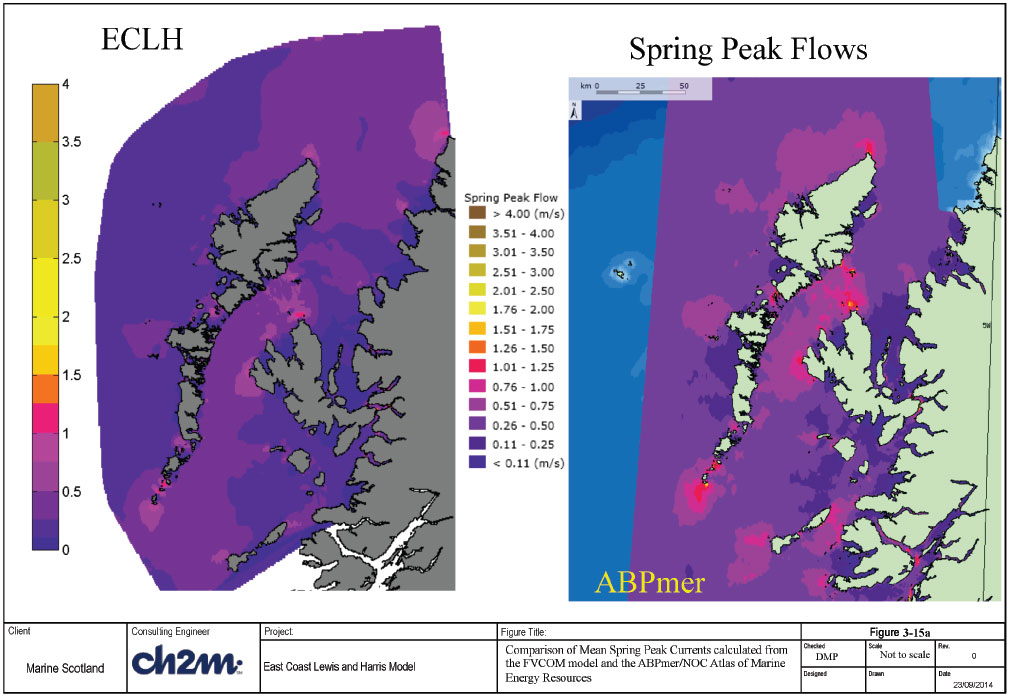
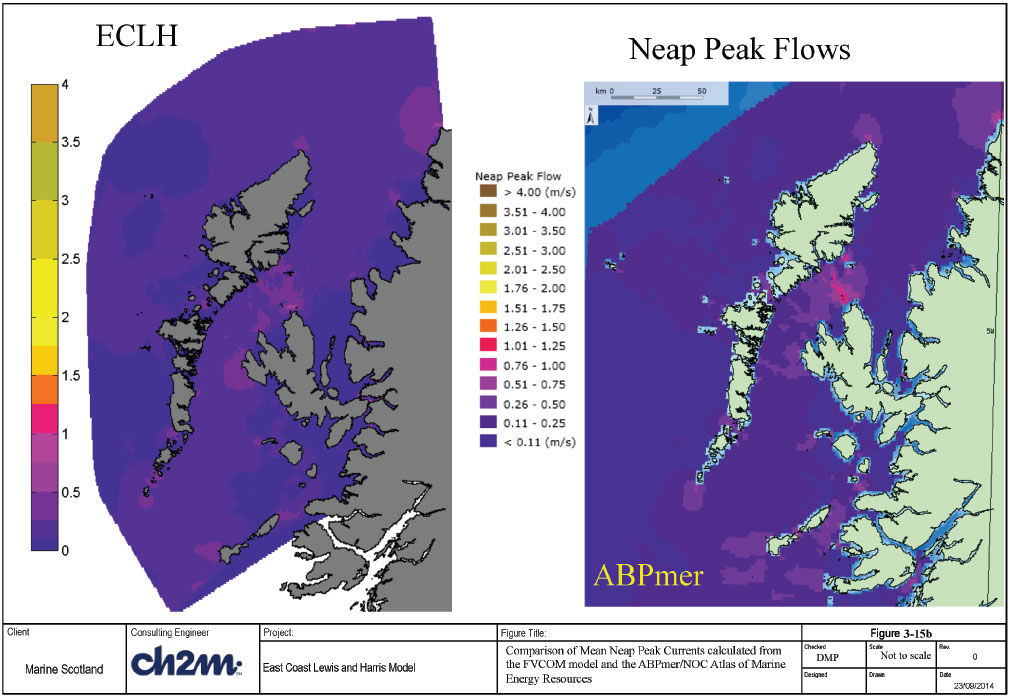
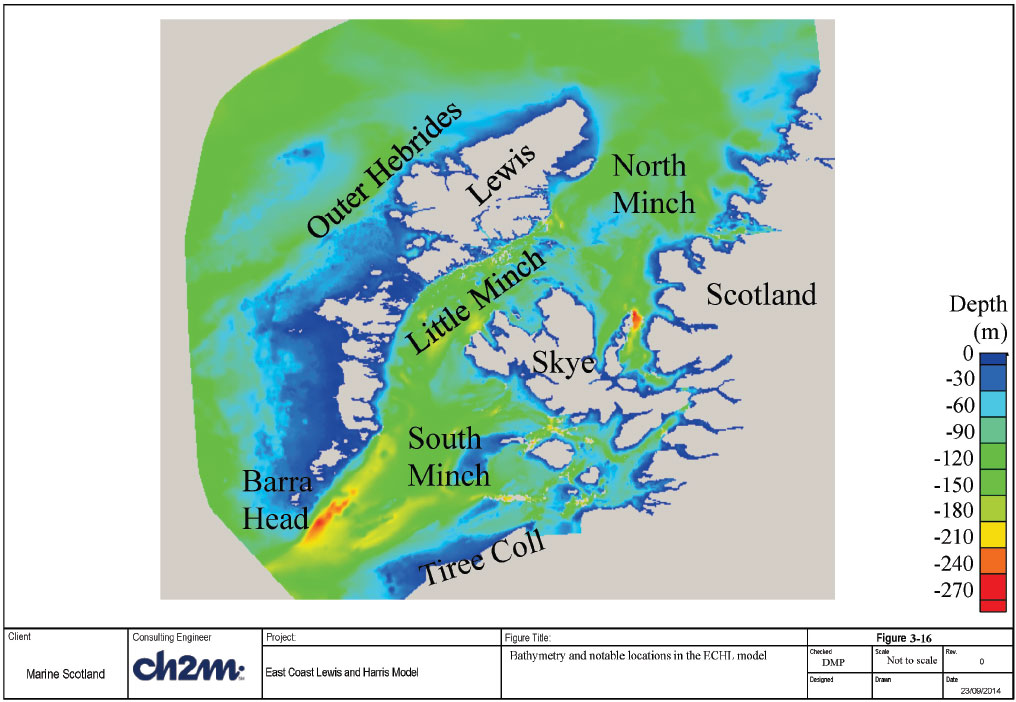
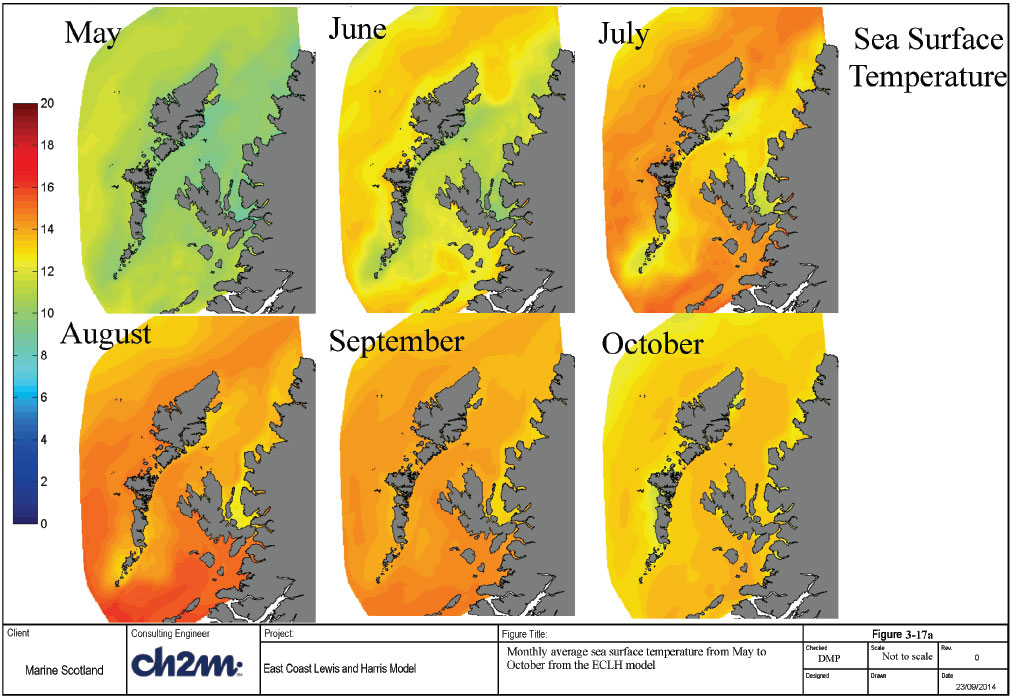
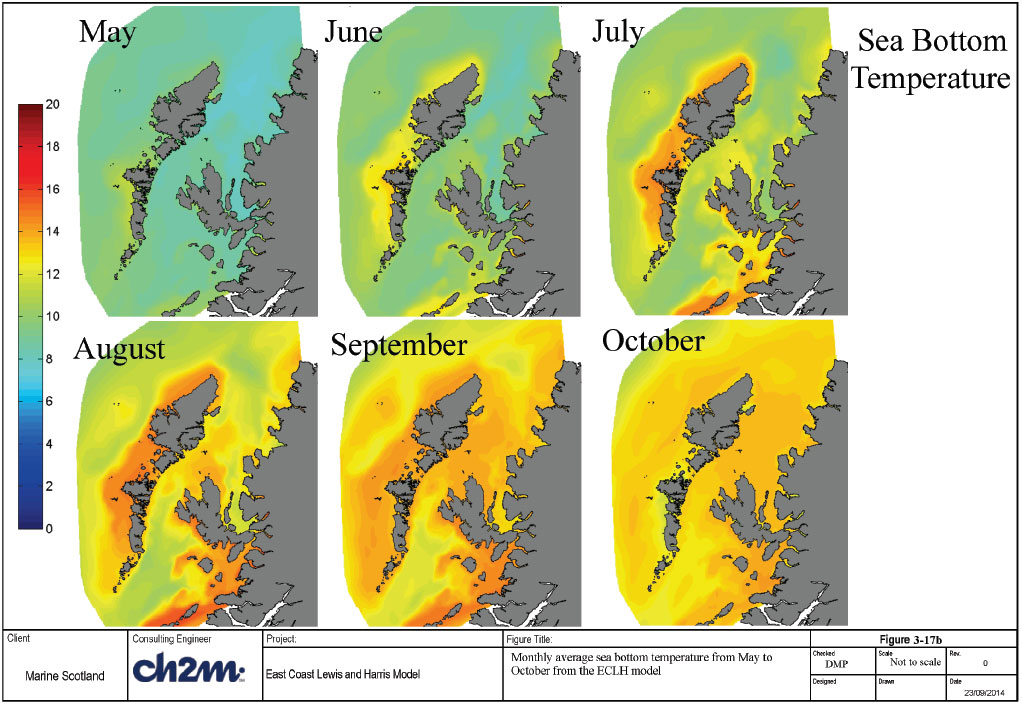
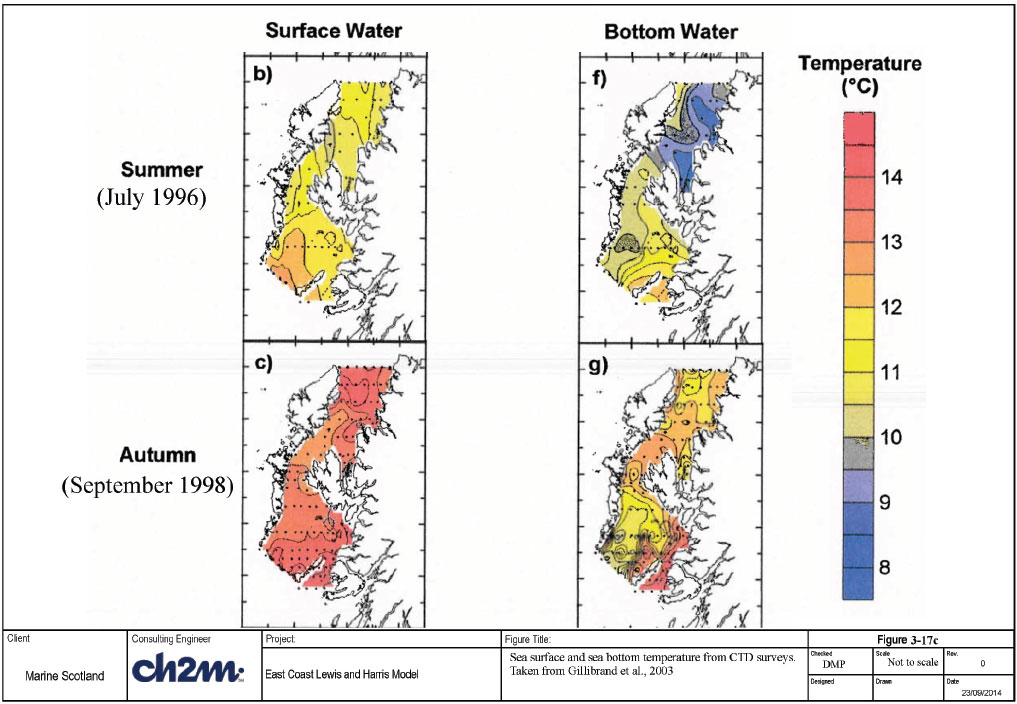
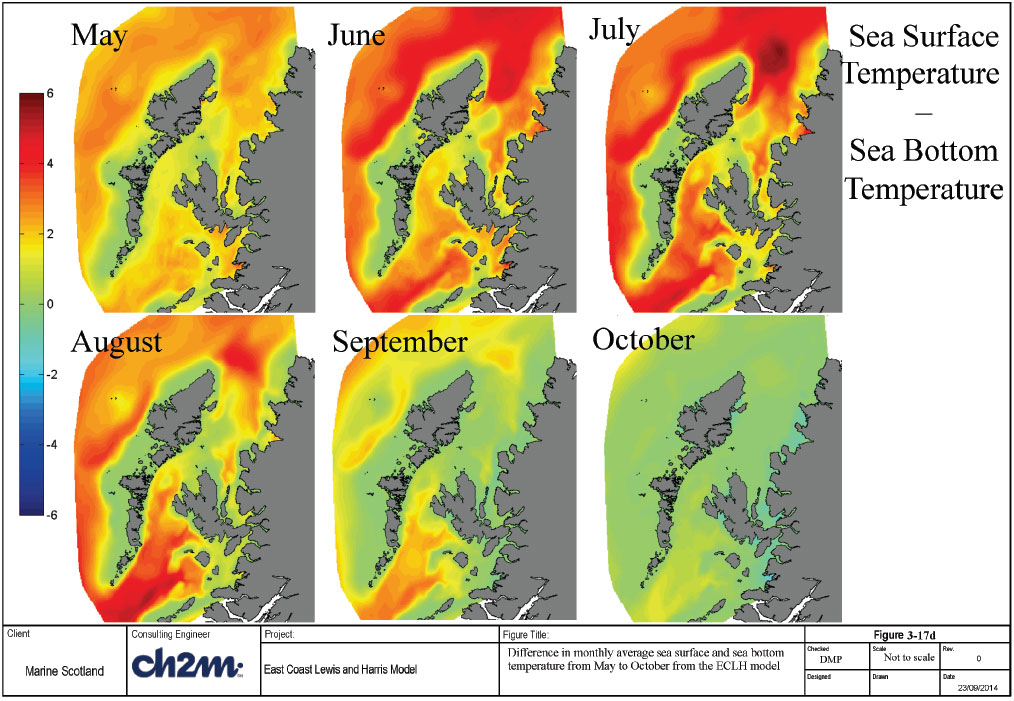
3.6.4.2 Salinity
The average monthly sea surface and bottom salinities are presented in Figure 3-18a and b respectively. The blue/green area of low salinity water along the west coast of the Scottish mainland represents the input of fresh water from river run off both within the model area and the area to the south which is brought into the model area by the northward Scottish Coastal current. The size of this low salinity area is at its greatest in May and reduces through the summer as rain fall decreases.
A tongue of high salinity Atlantic water in the South Minch is visible in both the surface and bottom salinities, creating a salinity gradient from the South Minch to the North Minch. This incursion of high salinity water was observed in the surveys by Gillard et al. (2003) (Figure 3-18c), although the incursion was not as defined in the surface salinities. The presence of this incursion was also documented by Hill et al. (1997) and appears to be a persistent feature. In the ECLH results the extent of this saline incursion seems to increase from May to September.
Figure 3-18d shows the difference between the surface and bottom salinities, as with the temperature differences this gives an indication of potential for stratification. The yellow and orange areas show where surface water has a higher salinity compared to the bottom water. Generally higher salinity water would be denser and therefore sink. The reason for this unusual behaviour may lie with the relatively higher temperature of the high salinity Atlantic water. Figure 3-17d shows that the surface waters in these areas are considerably warmer (around 3 to 6 degrees). The scale of the salinity variation in these areas increases from May to July reducing again towards October. The blue areas show where the surface water is fresher than the deep water giving an indication of the movements of fresh water within the model. In May a large area of the Minches and an area off the west coast of Lewis have lower salinity water at the surface than at depth, this coincides with high inputs of fresh water over the preceding months. These areas with fresher surface water (blue) reduce in size through the summer and increase again in September and October.
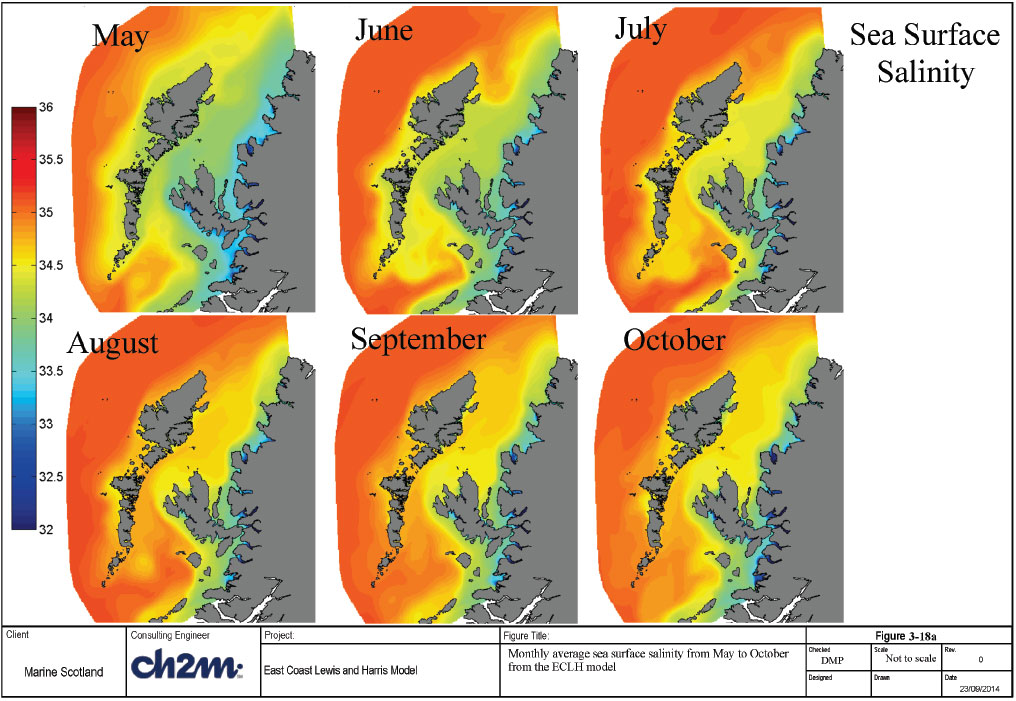
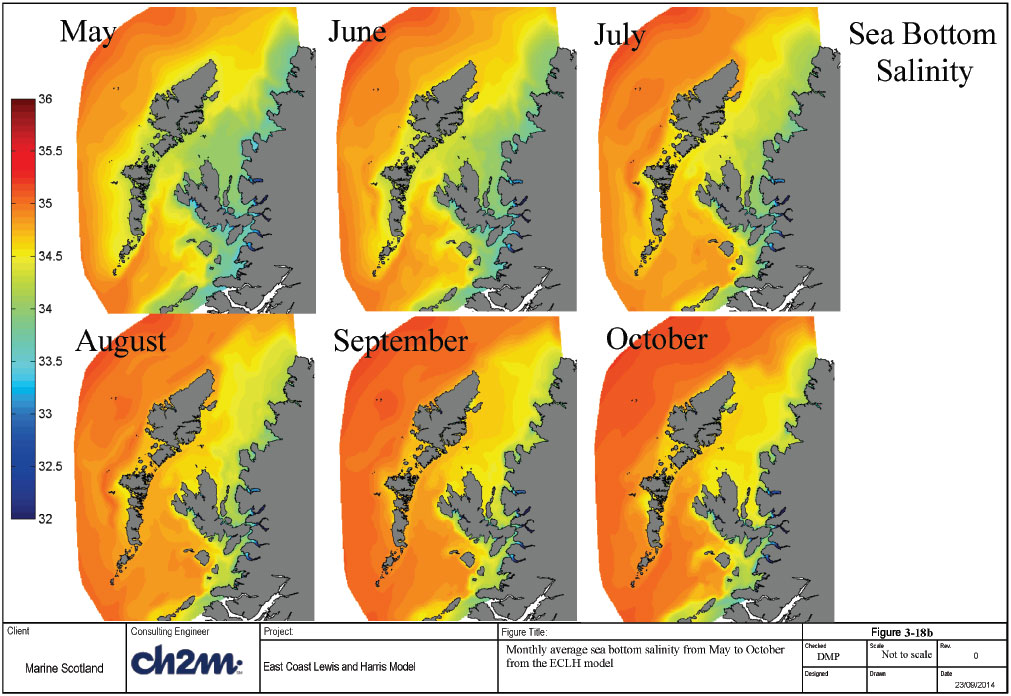
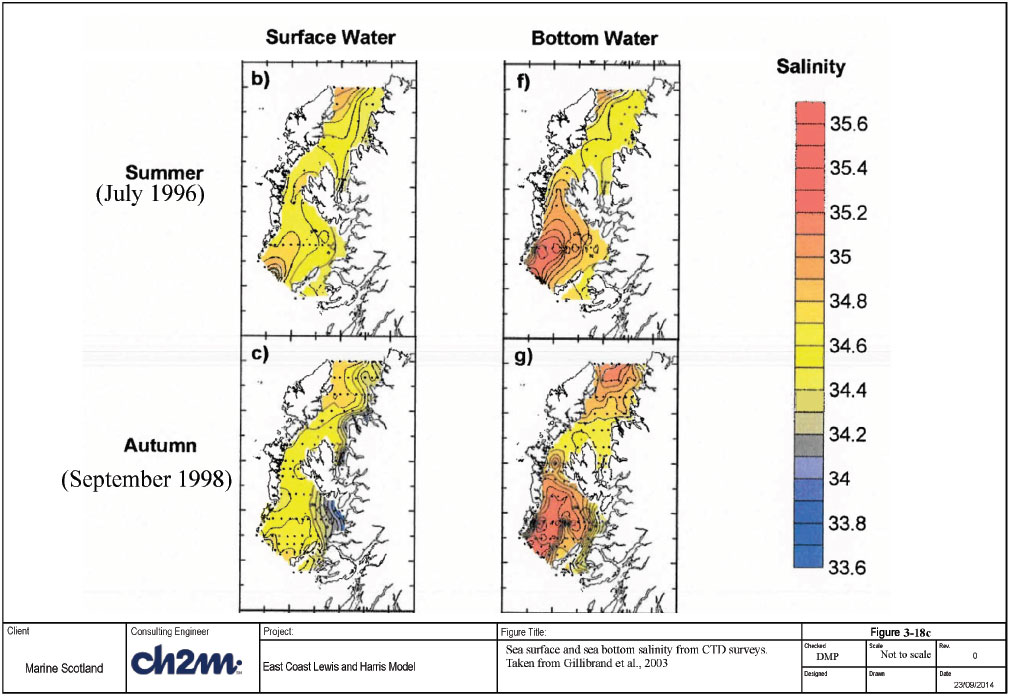
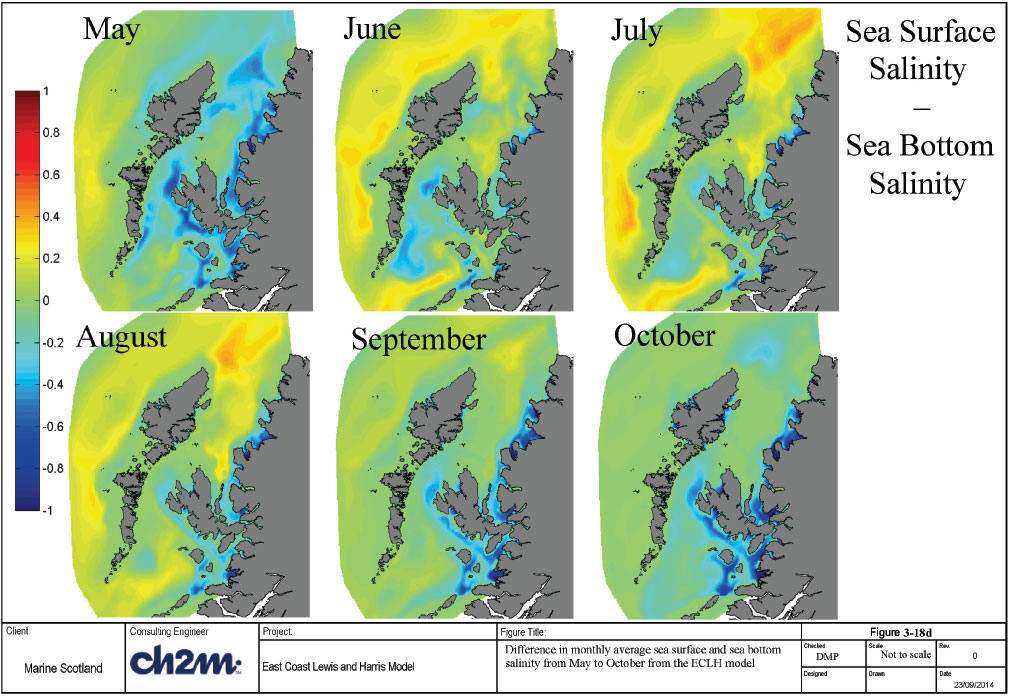
3.6.4.3 Residual Currents
The surface residual currents for each month for the whole model area and zoomed into the area of interest are shown in Figure 3-19a and b respectively. For all months the overall residual flow is to the north, with slower circulating flows in the North and South Minch. The strength of the residual flow does vary, with the peak in residual flows seen in July, reaching 0.4 m/s along the west coast of Skye through the Little Minch. The path that this peak flow takes varies from month to month as does the pattern of circulation in the South and North Minch. In May the northward residual current splits west of Tiree, the western branch head north towards Barra before turning east forming a clockwise circulation in the South Minch. The eastern branch travels along the east coast of the Little Minch, close to Skye reaching the east coast of Lewis and Harris just south of East Loch Tarbert. It flows along the coast turning to the east near Stornaway toward the Mainland then north along the coast. A weak anticlockwise circulation is formed in the North Minch above the peak current flow path. Where the north flowing residual current reaches the east coast of Harris some of the water is diverted south along the east coast of the Hebrides to Barra Head where the current turns northwards once more.
In June the northward residual current follows the coast of Tiree and the Small Islands more closely, passing the Isle of Skye and flowing through the Little Minch to the west of the channel reaching the east coast of North Uist before continuing north along the path it followed in May. The shift in the northward residual in the Little Minch appears to have weakened the southward flow from North Uist to Barra Head and an anti-clockwise circulation around the South Minch begins to develop which strengthens in July and August. In July the pattern of the residuals in the South and Little Minch are similar to that seen in June, however the residual no longer turns east to the mainland in the North Minch, but continue north up the centre of the channel. The pattern of the residual flows within the Minches remains unchanged until September when the northward flowing current begins to migrate to the east side of the Little Minch, the anti-clockwise circulation in the South Minch breaks down to be replaced by a clockwise circulation in October. The east ward shift in the northern flows coincided with a strengthening of the southward flow along the east coast of the North and South Uist and Barra.
The bottom residual currents for each month for the whole model area and zoomed into the area of interest are shown in Figure 3-20a and b respectively. The residual currents in the bottom layer are much lower than at the surface. And the flow patterns are not so well defined. There is still a general northward trend in the residual flows in all months between May and October. There seems to be a northward flow up the western side of the South Minch, through the Little Minch to the North Minch and beyond to deeper water (Figure 3-16) and a southward flow in the shallower water of the east coast of the Hebrides. The southward residual flow is strongest in June and July and weakest in October.
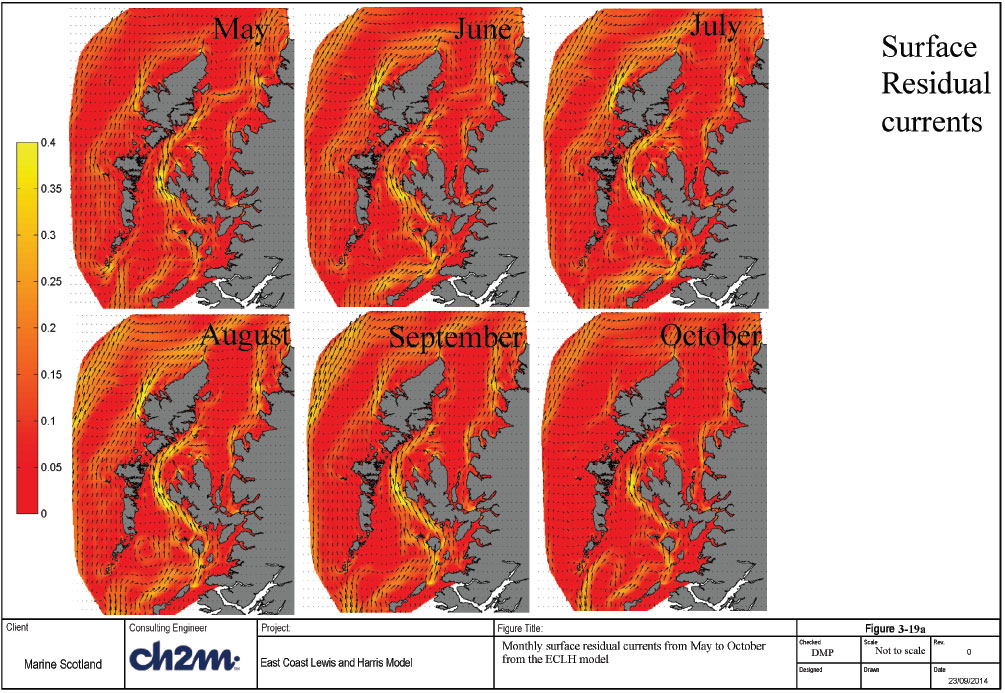
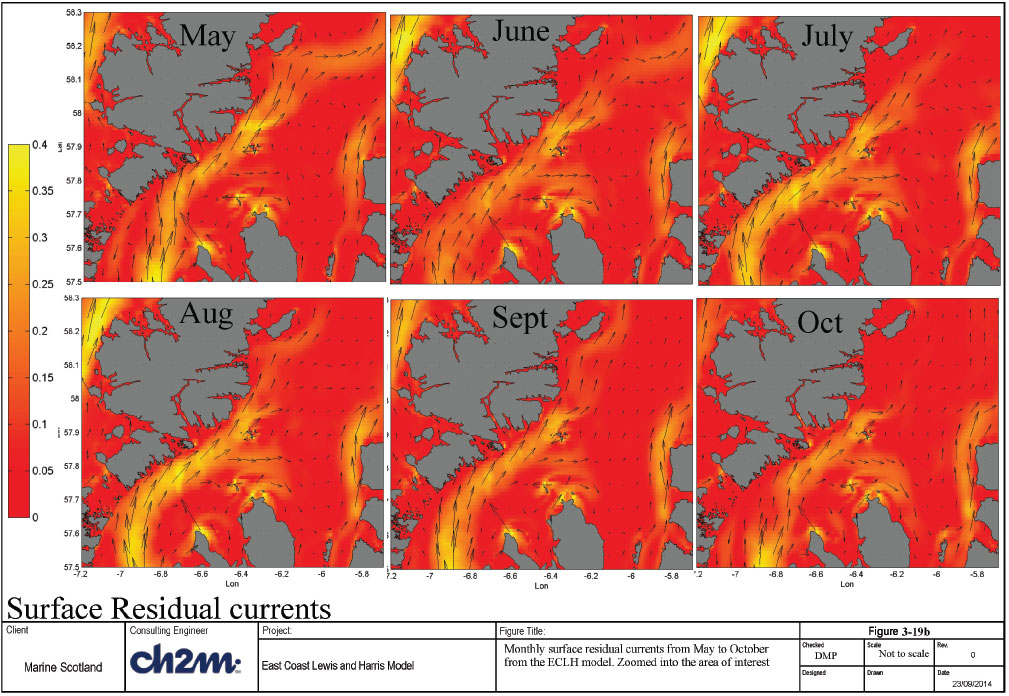
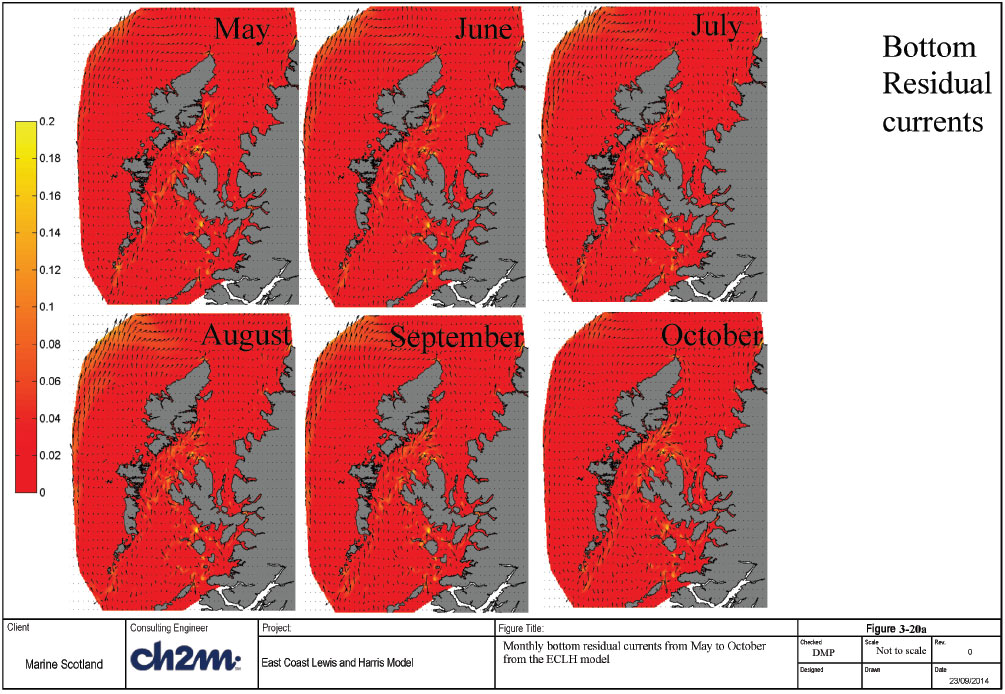
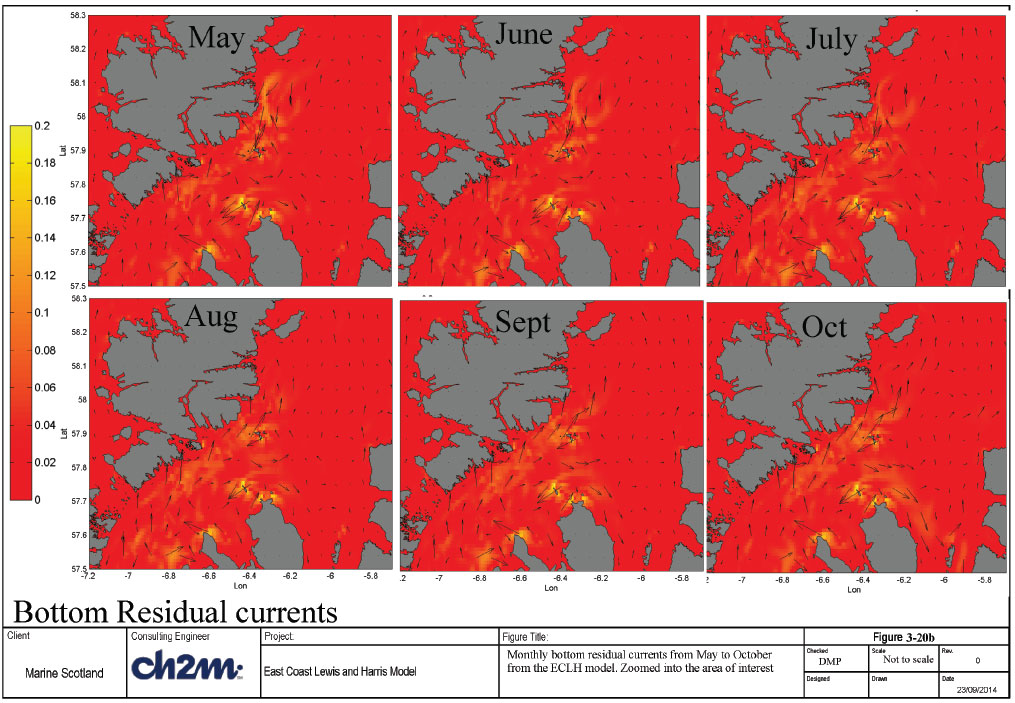
3.6.5 Discussion
Previous research into the hydrodynamics and seasonal characteristics of the area covered in the ECLH model have highlighted a number of interesting features. Most notably the presence of low salinity water around the Outer Hebridean Islands and the intrusion of high salinity Atlantic water into the South Minch. The small amount of freshwater discharge the Outer Hebrides produces indicates that the source of the low salinity water is not local. The distribution of radiocaesium ( 137Cs) released from the Sellafield nuclear reprocessing plant in Cumbria showed that the source of this low salinity water around the Outer Hebridean Island chain was not only the west coast of Scotland but also a proportion from the Irish Sea waters. The existing research indicates that the mechanisms by which this low salinity water can be transported to the Outer Hebrides is advection by residual currents (Gillibrand et al., 2003, Hill et al., 1997). Based on drifter experiments and the modelling results of Xing and Davies (1996), Hill et al., hypothesised that the circulation in the South Minch was a result of baroclinic density fields around the intrusion of high salinity Atlantic water.
The FVCOM model reproduces the intrusion of high salinity Atlantic water. The surface residual currents do show evidence of anti-clockwise circulation around the South Minch (Figure 3-19). The surface and bottom salinity difference plots in Figure 3-18d do show the distribution of low salinity surface water around the Minches which coincide with the patterns of the surface residual currents indicating that the fresh water is transported by the residual currents to the Outer Hebrides. The seasonal variations seen in the residual currents and the temperature and salinity fields indicate that the strength of the circulation is greatest in May and October, reducing in the summer months when the supply of low salinity water for river discharge into coastal waters is at its lowest.
3.6.6 Summary
Section 3.4 describes the climatology run for the ECLH model. The input data used was taken from the Shelf Model for boundary conditions, CEH for rivers and ECMWF averaged data for the meteorological forcing. The model was run for six months (May to October) the results have been compared with sea surface temperature and salinity climatological data sets for the months of May, August and October. The mean neap and spring tidal ranges and peak speeds were calculated and compared with the ABPmer tidal Atlas. There is some variations between the ECLH results and the available validation data but these variations are thought to be related to the difference in model resolution. ECLH has a finer resolution and includes a number of Lochs that are not included in the lower resolution models including Loch Alsh, the narrow stretch of water between the Isle of Syke and the mainland.
Consideration of the seasonal variations in temperature, salinity and residual currents in the context of existing studies has shown that the ECLH model can reproduce the spatial variations in temperature and salinity fields. Its results support the findings of previous research into the hydrodynamics of the area and provide further insights into the residual flows around this complex region.
Contact
There is a problem
Thanks for your feedback